The Internal Comms Podcast

Episode 74 – Culture with sticking power
The Internal Comms Podcast is back for Season 9!
To kick off this season, we welcomed BizJuicer’s Andy Goram to the hot seat. Andy’s passion for building businesses ‘from the inside-out’ aligns rather nicely with our own ethos at AB, and makes him the perfect guest to help inspire and inform our listeners.
Andy’s formative working experiences were in hospitality, learning the power of relationship building for success in front-line service roles. He calls this “lifting the curtain on ‘have a nice day!’”, as behind the pleasantries was a real desire to connect with the customer in a genuine and authentic way. This thinking has followed him throughout his brilliant career, and guided him through the transformation of one of the UK’s biggest bingo businesses – where customers and colleagues are like family – Gala Bingo.
In this episode, Katie and Andy explore the power of being human and leading with care in the corporate world, but also the impact of constructive guidance on creating culture that goes the distance. Andy brings reams of experience to the mic, including some hilarious anecdotes from when he was finding his way in the working world, and when his ego needed checking.
We hope you enjoy this latest episode, and if you have any thoughts or comments on this episode, share them using the hashtag #TheICPodcast. And for more content like this, make sure you’re following us on Twitter at @abthinks.
Transcript
Katie 00:03
The Internal Comms Podcast is brought to you by AB, the world’s first specialist internal comms agency. For nearly 60 years AB has worked, hand in hand, with internal comms leaders around the world to inform, inspire and empower their workforces building great organisations from the inside out. If you’d like to discuss new, effective, exciting ways to connect with your people, please get in touch. Visit abcomm.co.uk. And if you do, I look forward to meeting you. And now, on with the show.
Welcome to a brand new season of The Internal Comms Podcast with me, Katie Macaulay. This show is devoted to those of you responsible for improving communication at work. Every fortnight I will be asking leading lights from the world of communication, academia and business to sit in my hot seat, where we will tease out practical real-world ways to help employees feel more informed, inspired and involved at work. We kick off season nine with Andy Goram.
Andy started his career in hospitality, where he says I lifted the curtain on ‘Have a nice day’. He then moved into marketing, where one of his biggest challenges was rebranding Gala Bingo, the UK’s biggest bingo business. And it’s during this project that Andy uncovered a deep human truth that lay at the heart of this brand. And this is just one of the many powerful stories you’ll hear throughout our conversation. During his time as a marketeer, Andy admits to spending millions on traditional marketing activities before realising that to make a real difference to the customer experience and business performance, you need to start inside an organisation. That realisation led him to establish Bizjuicer, his consultancy business, which is all about creating a sustainable competitive advantage for growing businesses by uncovering, articulating and connecting an organization’s purpose, vision and values to their people.
Andy is also host of his own podcast Sticky From The Inside, where he interviews experts on workplace culture, employee engagement and business performance. Both marketing and HR are in the attraction, retention and growth game, says Andy, they just have different target markets. And throughout this conversation, you’ll hear Andy talk about the magic that happens when these two disciplines form a closer alliance. We mentioned a few books throughout this conversation, all of which you can find in the show notes. And he talks about the influence of Kim Scott’s book, Radical Candor, and her concept of ruinous empathy when as a leader or manager, we avoid those difficult, critical conversations with someone because we fear hurting them. We talk about the service profit chain, a book that some 26 years ago established the now indisputable link between customer loyalty and employee satisfaction. I really couldn’t have asked for a better guest to kick off this new season. Andy’s passion for this inside-out approach to building better businesses is completely infectious. We talk about vulnerability, leadership, dead simple ways to build trust and the hard thing about soft skills. I love this conversation, and I hope you do too. So without further ado, here’s Andy Goram. So Andy, welcome to The Internal Comms Podcast. It is a delight to have you here.
Andy 04:31
I’m so happy to be here. I can’t tell you, Katie, it’s so nice and weird being on the other side of the mic for a change. So, yeah, I’m really looking forward to it. Thank you for having me on.
Katie 04:42
That’s a pleasure. We’re going to start in a slightly strange place, but listeners, there’s a method in my madness. Andy, can you tell us about where you learned or maybe from whom you learned your work ethic?
Andy 04:59
Oh blimey. This is assuming that I work really hard, right? I really value hard work. Simple answer. Mom and Dad worked really hard, right? Mom was a childminder, dad worked as an IT director for a holiday company. But I have to principally hold up Betty and Rosemarie. Betty and Rosemarie were two ladies of later years, shall we say, that ran a little bakery patisserie out the back of Tattenham Corner in Epsom near the racecourse, right? And as a 16 year old, I really wanted to be a pastry chef. I figured I would be the next Michael Nadell. Anybody into pastry knows who Michael Nadell is, but anybody else is going: “yeah, no clue.” But anyway, I wanted to be like him. And I was given the opportunity to go and work in their kitchen on Saturday mornings, getting there for 6 am, I absolutely loved it. My very first job in there was making lemon icing, so the huge ingredient mix of icing sugar and lemon juice. That was my very first job. But I learned so much in that place about work ethic, and effort, and fun and engagement. Without trying to crowbar engagement in, I think, the fact was, I was earning a pound an hour, which was not very much even by those days, right? But I’d be volunteering, Katie, to work over the weekends in Easter and Christmas. You know, decorate in chocolate logs. I mean, no one could stand, none of my mates could stand being near me in Easter because I just had this reek of bun spice about me, you know, go to the pub, “what’s that aftershave you’ve got, Andy?” That’s sugar water and cinnamon, and clove oil. That’s, that’s what that is, mate.” But I absolutely loved it. They worked so hard. I mean, they were there well before I was ever there. They left well after I left. They taught me so much. They were so patient. But they kicked my backside around that kitchen. They expected you to work really, really hard. And even if I wasn’t decorating cakes upstairs listening to the radio, I was on the floor using a scraper to get all of the kind of flour and sugar and crud off the floor at the end of the day or shoved up the top of the ovens to clean those because they could get dusty. It sounds quite Dickensian, but it really wasn’t. It was a wonderful, wonderful work experience for your first job. And for me, that’s kind of seen me through the whole time, that combination of loving what you do, really being engaged in what you do, working really, really hard at it and having fun while you’re there. It’s a great formula.
Katie 07:44
And do you still have a signature dessert that you’d like to share with us?
Andy 07:48
Listen, there is a need, there should bed. People keep telling me there should be an e-commerce site at Christmas because I have, let’s say, I’ve evolved the humble mince pie on a few steps, and you know, people like Heston Blumenthal copy these, these ideas I have. But now my go to at Christmas is the Viennese topped mince pie. So, that is a mince pie, a shallow mince pie, topped with a lovely rosette of Viennese biscuit. So, you get all the lovely spice and luxury of the minced meat, and what have you. And you this beautifully buttery, just melt-in-the-mouth nice Viennese biscuit on top. So all my family want those, all my friends want those. You know, I think, how many did I make this year? I probably made about 20 dozen of them, this year, this Christmas.
Katie 08:39
Oh my goodness me, speaking as someone who hasn’t had breakfast, I hope you’re not going to stop to hear my tummy rumbling. We are going to fast forward now because you went on to work in hospitality. And when we were speaking earlier, before this show, you used a phrase which really piqued my interest. You said: “I lifted the curtain on Have a Nice Day.” And I thought oh, what a wonderful, what a wonderful phrase. I’m just curious, what did you find behind the curtain, first of all, and then how did that experience subsequently kind of change or shape your thinking about culture and engagement?
Andy 09:20
It was really interesting. It was a proper Taylor Paradox. So, as part of my university degree, I had to get a job abroad, ideally to back up the language that we were doing. But I was doing Spanish, and I couldn’t find a place in Spain, and frankly, I didn’t really want to find a place in Spain. Not when I had someone who tapped me on the shoulder on a family holiday a few years before and said, “If you ever need a job in America, let me know. My brother runs a hotel. His brother ran the Pebble Beach Company in Monterey, California. So the home of the Pebble Beach Golf Pro-Am tournament is out there.You know, the lodge at Pebble Beach, the sister property of the Inn at Spanish Bay. So I went and worked at the Inn at Spanish Bay for well over a year as a concierge. Just completely incidentally, Katie, right? If you ever find yourself going abroad and looking for a job, concierge is the greatest job you ever get because it’s a job where you have to learn the area, right? You have to learn all the really nice things that area has, places to go places to eat and drink, particularly where you can drink. Because all these restaurants want you to recommend their place, they want you to come and see it. They want you to experience it. So I spent my life pretty much going out, experiencing amazing restaurants and great places to drink for free, to then offer and recommend them to customers who would tip you for recommendation. It’s just a beautiful virtuous cycle, right?
Katie 10:49
Win win on every level.
Andy 10:51
Yeah. But as part of that, I went through the hotel’s customer service training, right? And so my impression of American customer service training was the force feed of ‘Have a nice day, missing you already.” And those phrases do exist. But, what I found behind the whole piece was some real, genuine authenticity with this desire to make a connection with the guests. I mean, in my own personal opinion, the American service industry has progressed so much faster than we had in the UK because the customer had evolved. You know, a British customer can sit there, have a meal, it’d be really mediocre or awful, and the the server comes over and says, “How is everything with your meal?” And we will look at each other, and then look at the server and go, “it’s lovely, thank you, thank you very much.” They will go away, we go on moaning about it. In America, if your water is a few degrees too warm, you will know about it, right? Now, because they are not afraid of complaining and have high expectations, the service industry has to evolve. But it’s no great secret. They just learned that if you’re a waiter or in the service industry, making a genuine connection with your customer is a great way of building a relationship and understanding, and the service journey goes a lot better. So lifting the curtain on “Have a nice day” was really the very simple premise of look, imagine you’re going through this experience yourself, what’s the best experience you could get? That you would think is a really, really great experience. And then, right, we’ll go and try and deliver that experience. And at the same time, make a connection with the person that you’re talking to, right? Make a connection, even for 20-30 seconds, be there, right? Be there with them. They’ll tell you pretty quickly whether they want you there or they don’t, and that’s a good way to kind of gauge service. You know, some people like to interact with with their server, other people just want you to deliver food and leave me alone, right? Great people in the service industry have this kind of ESP to work that out. We were taught that ESP, and you get that from making connection, right? From sussing people out. But I think the really big thing was trying to make it as genuine as possible, because you can see through the veneer, and that’s the paradox I was talking about. Our impression over here, back in the 90s of “Have a nice day” was just programmatic response to someone who didn’t really mean it. You’re dead behind the eyes, you’re saying “Have a nice day.” The really cool thing behind it was, no, this is an attempt to make a connection, right? And make a genuine connection. And to be fair, as may well come out in this conversation today, this making a genuine connection has tended to be the red thread throughout my career, really.
Katie 13:41
Let’s move on, then. Because from hospitality you went into marketing. You did say to me that quite early on, you realised that marketing wasn’t advertising.
Andy 13:54
Yeah, I’m not a clever person. So you know, marketing advertising was one big lump as a module as part of this International Hospitality degree that I was doing. And I came out going young going to go into marketing, thinking I’d be, you know, maybe set with a creative, you know, us living our lives, talking about brands and products and coming up with adverts, and you realise pretty quickly when someone’s asking you to copy check a leaflet that marketing is very different to advertising. But I’ve loved my career in marketing to a point really, yeah.
Katie 14:26
You were very honest when we spoke earlier about certain time in your career when I think a new director called you out, and it ended up being a turning point in your career. Are you happy to share that experience with us?
Andy 14:43
Yeah, I’m happy as long as you don’t mind me crying. I still kind of get emotional about this sort of stuff. I guess it’s in the middle of my career, I’m working for a big pop company at the time. I had come to this first my first big company after working in a small hotel group for a little while. And I couldn’t believe I was working in a business that pays you to go out and drink and enjoy pubs and restaurants. And you’re working on the brand side, you’re working on promotions, you’re working with suppliers, what have you. And it was great. And, you know, I progressed pretty pretty quickly, I thought was pretty good. And I got a bit of a reputation as a guy who could do things. And I made the massive mistake of really believing my own price. And I thought I was a bit special, I got pulled out for CEO tasks and MD tasks, and all that kind of stuff. And I felt I was a bit untouchable, which I think resignated itself in a bit of a poor attitude, nothing nasty, not that sort of attitude, but just a little bit cocky. And I think at that age, I was just lacking some self awareness. But we had a new commercial manager come in to the marketing team. And I say he was a small man, because I was 663 and full of myself, and a small man set in front of me. And in our first one to one together, he’d started the conversation with something like, “Okay, Goram, if things don’t change, you’ve got to find a new job.” And I’m like, “okay, in which department?” And he’s like, “no, no, no, another company.” And I’m, I’m kind of shocked, stunned, affronted, but this major part of me, entirely embarrassed. Because I probably know that he’s called out my attitude. And, at that point, you get a massive dose of self-awareness pretty quickly. And, you know when you know, you’ve done something wrong, and you get that cold hair piece at the back of your neck. Yes, I sat there in this meeting, I found it really hard to concentrate with what he was saying. But he pretty much, systematically, but in a supportive way, just showed all my failings. It was a big, big thing for me. And I didn’t really know what to do at that point. The journey home that night was a very, very quick car journey. It wasn’t, it was 70 miles, but it went so quick, because I just couldn’t stop thinking about stuff. And I think I’d be honest, if I said, the next day, everything changed in terms of my attitude. I think I’ve been brought up to be a good guy. You know, do the right thing, be polite, all that, you know, all those kind of good values. And when someone calls you out like that, that’s a pretty stark thing to hear. And I didn’t want to upset anybody. I didn’t want to do things wrong. I didn’t want to get into trouble. But it made me reassess. And to be fair to Richard, he saved my career, I think, because if I’d gone on and continued to behave like I did, I certainly wouldn’t have gottten the opportunity I eventually got in that organisation which changed my direction. And I would have gone on being the cocky, boastful idiot who thought people loved him, but probably was the kind of guy that a good laugh with and then when he walked away, I thought he was a bit of a tool. And I don’t know, maybe people still think that about me. But I will be forever grateful to Richard. And do you know what the beautiful thing is? A couple of years ago or so in lockdown, I reached out to Richard because I hadn’t really kept in contact, and eventually got to sort of speak to him. And he was completely unaware of it. He just thought, just doing my job. And he really didn’t want to make a big deal of it at all, which I think, is wonderful because that to me, that’s what leadership is about; you don’t make the big thing about it. You go on and you do your best for people. He says, “I thought you’re better than you are presenting yourself, Andy,” and so we had a chat about it. The fact is, no one else had. You know, to me this all links to the sort of Kim Scott ‘Radical Candor’ stuff. I sat there in this first meeting with Richard thinking, who is this guy telling me this stuf? And it was only because he cared deeply about me that he was confident enough to challenge me directly, right? But he was the first person in my career properly who had done that. So I will always be eternally grateful to Richard and it sort of set me on a path. I am not saying I was the perfect leader after that point by any stretch of the imagination, and I’ve made hundreds of mistakes, but they’ve all led me to a path to understand what it really, really should be about. And Richard kicked me off on that path, you know?
Katie 19:43
I think it’s a wonderful story. It really talks to the importance of, as you say, that he didn’t think it was a brave conversation. He thought he was just doing his job as the leader, but actually many of us would think it was a brave conversation. How many times have we tried to just brush something under the rug and hope that it just goes away? And actually, it was a moment in time that you’ve never forgotten. So, yeah, I think that’s amazing.
Andy 20:06
I think, you know, that whole model of Kim Scott, I feel if I look back, I probably lived the vast majority of my early career in ruinous empathy, trying to be everybody’s dad when I was a leader, and look after everybody, not call stuff out, but just make sure everybody’s feeling okay. And actually, people don’t want to dad, they want a leader. And I think when you genuinely care about the people who are lucky enough to lead, then it’s your absolute duty to help them be the best that they can be. And that means praising them when they do amazing things. But it also means, like Richard did, have the tough conversations, call them out. And I think that that’s what the essence of real leadership is about.
Katie 20:52
Without trying to shoehorn something in, there’s a thread running through this already, from the minute you talked about your work ethic to here, which is that engagement and feeling really engaged, and performance that absolutely linked, you know. Anyone that still thinks that engagement is some kind of fluffy, woolly, nice to have thing — oh my goodness me, it is all about better performance.
Andy 21:21
Engagement is an outcome, Okay? It’s, it’s been diluted down to a measure. But that’s not what this is about. You’re hitting all of my triggers because people who talk about this stuff being fluffy, particularly when people refer to things as soft skills, winds me up. Because there’s nothing soft having really good mastery of being a human being, and managing people on a human level, right? Because if it was that simple, I’d have nothing to talk about, I’d have nothing to help businesses about. Because it will just be common practice. The fact that it’s common sense doesn’t mean it’s common practice. And it isn’t common practice. And there is nothing easy in having those conversations. If you haven’t never had those conversations, if your personality type would like to avoid conflict, that doesn’t make it easy. Does that mean you can’t do it? Not at all. It just means you need to be conscious of it, you need to be intentional with it. And, like a lot of things, you need training in it, right? You need practice. Engagement is the key to unlocking so many great things. Like even my company name, which is an over-thought name by marketing, what a surprise. But it’s all about getting the good stuff out of the people in your business, right? There’s so much latent opportunity, innovation, energy, ideas, sitting within the population that you work with, that is just untapped. Because sadly, in most cases, people haven’t been asked for that information. Or it’s just taken that they’ve got a job and that’s what they do, and they’re here to do that. There’s nothing else to it. The thing is, engagement isn’t always about all the happy stuff as well, and agreement. Engagement means you’re happy to challenge something, because you’re interested, you’ve got a vested interest in it. And challenge is one of the great things. When we work stuff through and we think about all the different angles, we come to a better conclusion. And so, for me, engagement is about creating genuine interest in what we’re trying to achieve, real connection between what drives the business and what drives the people within it. Finding those connections is where engagement lies, right? Having an interest willingly going above and beyond what you think you need to do to go and do it because you care about something. To me, that’s what we talk about when we when we talk about engagement, and wonderful cultures are just fueled by this stuff. I think it is worth touching on the challenge you were actually set after that moment with Richard, because am I right in thinking you were involved in a transformation project to almost reengineer the business to be more customer-focused? Yeah, I had my greatest job title given to me, which was the mad director, which has helped me have interesting conversations with people forever on my CV. What’s this? So the mad director was all about trying to get the business at the time, and now it sounds ridiculous, but have a real focus on the customer and the customer experience across the whole business. So people really took an interest in what the market was doing, what the customers were doing, what they wanted and how to delight them. And my job was to think about service and insight. And I didn’t know at the time, but culture and engagement really. And I spent a couple of years, I guess, drip-feeding this stuff through the organisation with some great people around me helping, to try and get everybody to think a bit more customer. It’s things we all take for granted now, but back in the day, less so. And it kind of moved me from the promotions and marketing guy into the customer engagement culture guy. My first values project came at this point, you know, helping determine the things that really are important to a business, and how they add value to the people within the business to help achieve objectives. That was one of my favourite projects that I ever did in that business. And now I get to do plenty of those sorts of things, right? That mad director roll, which for me was about making a difference. That’s how I kind of changed the acronym, making a difference for customers in their experience. But you can’t just focus all on the customer because you’re a service brand. And so, your service brand lives and dies by the people who deliver that brands of the customer on the frontline every day. For a lot of my time, I was working with support teams in the centre, they need to understand that their customers are dealt with other guys on the frontline, not some holier than thou, ivory tower central team who told the operators what to do. You’re there to support them to deliver a great experience, right? So a lot of what we’re doing was about trying to create those relationships and understandings as well. So yeah, my mad director role was a pivotal part for me, and I absolutely loved it. Absolutely. And it changed my direction. I still after that went and did some brand roles in other companies, but it broadened my view on things. So I might have been employed to do a marketing job on paper. But they always ended up being more experiential, as a result. And I’d crossed that paradigm of doing marketing promotions into a blend of marketing, operations, and people. I’ve always kind of ended up from that point on seeing myself sitting in the middle of those departments, trying to find the customer truth, the brand truth and the employee truth that kind of linked everything together. I’m not a massive believer in having consumer facing brands and employer brands within the same brand. For me, it’s one thing, it’s one attitude, it’s one belief system that should work together in harmony. And that’s where I’ve ended up going, you know? That’s where I ended up taking a lot of my roles, and that’s why eventually when the corporate world wasn’t doing what I needed it to, I left.
Katie 27:39
I think that’s so interesting. I think we’re seeing ever more, aren’t we, closer and closer alignment, almost blurring of the line completely between internal external, and total awareness, well hopefully a total awareness, that your employee experience drives your customer experience, and that they can’t be thought of in silos.
Andy 28:02
We should all be aware of the service profit chain. Look, don’t ask me to rattle off the authors of that book, because they’ve all got names I find hard to pronounce. But there’s Heskett and Schlesinger, that’s the one who I really struggle with. And Saskia (Sasser), I think? They wrote that original book, Service Profit Chain. I probably got some of their names wrong, okay? This is what happens with me.
Katie 28:26
That’s what shownotes are for, don’t worry.
Andy 28:28
There you go. That book, which essentially sort of says, happy employees equals happy customers equals happy shareholders is an old message but one that should never be forgotten, okay? Great service brand delivery. And not just service brand, but that’s primarily been my experience. The be-all end-all of it is how it’s delivered on the floor by the people every day in front of customers, because if they’re having a bad day if they don’t get something, if it’s not working, if they haven’t had something explained properly, that’s the impression that the customer gets of your brand, product, service, whatever it may be. The closer that you can get to the people who deliver that brand to understand what it is you’re trying to do, why you’re trying to do it, and knowing their part in delivering that and enhancing that, the greater shot of you getting the experience you’ve conceptualised and built around the board table actually being delivered in practice? And as a marketer, I can sit here being all preachy about it, but I spent millions trying to tell customers “Hey, look at us!” Why should you consider us? Why should you buy with us? Why should you stay with us? Why should you recommend us to anybody. I spent billions of pounds explaining that, and two fifths of naff all on engaging my internal audiences. When I learned that lesson, and then it wasn’t essentially learning a lesson because it had gone wrong, it was just uncovering something else that enhances the result exponentially. You never go back. You’ll never go back, you’ll always be looking at, right, how do I engage that internal audience? How do I help them understand their part in this? How do I take all of our thoughts, wishes, ideas, criticisms, and what we do, and how we can make it better, because there’s loads and loads of answers out there that are just waiting, waiting. If I had my time again, Katie, I’ll be awesome, right? Because I’ve learned so many lessons about leadership and so many lessons about audience engagement, that I would do things very differently going back. I’d start inside, genuinely. And not just because my businesses, they’re trying to do that now. Genuinely, I’d that because it works. It works.
Katie 31:01
It works. Let’s talk about a very practical experience of this at Gala Bingo, and establishing that brand. So for people that don’t know, it’s Britain’s biggest retail bingo operator.
Andy 31:15
Well, it was Katie, it was. It was my job to change it, because I was the Chief Brand Officer, CMO, whatever you want to call it, for Gala Bingo retail. But we did an MBO as an executive team there to buy the retail clubs because the all powerful rest of the company want all the online stuff. So we were running Gala Bingo on licence, but that’s no good, especially if you want to build an omni-channel brand of your of your own. So my job was to rebrand Britain’s biggest retail bingo operator, not lose any of the 10 year in heritage and all the rest of it, completely separate it, and then set it up for a new omni-channel world. So, I’m the guy that had to change Gala Bingo to Buzz Bingo. So Buzz Bingo is its iteration. Now, I don’t think there are many people who wake up in the morning and go: you know what, I really want to be the marketing director for a bingo company? I’m sure there are people, but It wasn’t me. But I’ll tell you, the six years I spent in that bingo business were amazing. I don’t think outside of hospitals, that there are many businesses where frontline employees and customers spend so much time together. So maybe four and a half hours at a time a session, and people coming in three, four days a week. I mean, this is this is family in these places. You know, the relationships that you see built between employees and customers is a real blurred line. In a regulated gambling business, that’s a that’s an interesting thing to think about, right? The link between, I guess, customer and employee was so strong. I would walk into a bigger club as a guy in a suit from the centre, and I’d be sitting down and trying to talk to the customers about how they were doing and what was going on and what did they like. That conversation was for nothing if the employees were unhappy about something, because I would get it from the customers. If the employees weren’t happy and had beeb talking about stuff, the customers knew and they would rip you to shreds when you walked in. “You got to look after these people, you’ve got to make sure they’re happy about stuff, because it impacts on our experience, and we don’t want to see them upset.” Yeah, really, really amazing. But the thing I found most amazing about bingo was how humble everybody who works in bingo is. And this was a trigger for a lot of things that I’ve thought about subsequently around purpose and engagement. And whenever you spoke to somebody working in a bingo club, they would describe what they do quite literally. So you know, I shovel chips, sell a lot of chips in bingo clubs, or I give out change for the interval games, you know, or I sell books. And, bless them — when you spend enough time in a bingo club and you watch what’s going on, that’s very, very little of what they’re really doing. And you watch them. And what they are doing is they are fashioning and creating relationships right across the club, right? They are connecting people who otherwise wouldn’t necessarily be connected, sometimes with themselves, sometimes with other customers, but they’re making connections. And when we’re doing the rebrand and we’re trying to find our sort of space to reposition ourselves, and have some new space but be connected to what we were really intrinsically about, I started to talk to the employees about their roles. And in one conversation, it started that when they were telling you what what they did, and I said, “well, that’s not my observation. My observation is you are creating relationships. In some sense, you’re banishing loneliness.” Because if you think about the archetypal customer going to a Bingo club, often the people that they see in that club are the mainstay of their community — the people they see. And yet, when they come to the club, and the reason they come to the clubs often, is because of they get a sense of community. And when you sit down and speak to the teams about this, I get goosebumps. You physically see a reaction in them. It’s like they sit up and they put their shoulders back and their chest puffs out. All of a sudden, they walk with a bit more purpose. And you see him intentionally going around the club doing this stuff. I spoke to a few about what that impact was, and they just said, it was nice to be seen, and that they felt really proud. I didn’t think I’m doing anything special. I’m just kind of shining a light on what they’re doing, because they’re the special ones. And we built a lot of the brand personality around them, and even in the design phase. I got a bit excited in the design phase of the logo and stuff. We had this animated piece, where I don’t know if you remember the Colgate ding, you know. So that little sparkle, I put a little kiss kind of sparkle on on the animated logo. And genuinely, because I knew in the future I’d be going, that was my little nod to everybody in the bingo club, that I know what you’re doing. And whenever I press whenever I presented the logo, when we were telling the story of the brand going forward, I always drew their attention to the little Colgate thing is, that’s my little wink to you guys, because this is all about you. Again, that was a great bit of fun and engagement. But honestly, the engagement we got was brilliant. It came down to a head one day. So, there’s a big retail brand, we’ve got a lot of faces and signs the change, practically. And I’m going out with our investor board, round one of the early clubs. And here I am trying to show you the bits and pieces that I’ve done, and all they want to do is go back of house. They go back of house, and this is where you take your heart and your hand because you know what they’re gonna see back of house, that’s not customer facing, right? And we walked down a corridor and there’s one of the sort of the big kind of brand engagement boards on there. And they offer engagement about lots of different sectors about what we’re trying to do and why. And an assistant manager comes down the corridor, called Colleen, and the board pounce on her, right? And they go what’s all this about on the wall now I’m like, Ah!
Katie 37:44
It’s the acid test!
Andy 37:47
My career is flashing past my eyes at this point, maybe I’m leaving earlier that I think I’m gonna be leaving, and Colleen, like takes a takes a beat, looks at the poster and starts telling her version of the brand’s story and, interestingly, the offer development. And I’ll tell you what, she told a story better than I could ever, ever tell. I was then looking at the board in this corridor, and they were looking at each other and nodding and smiling. And at that point, I sort of backed up and thought, you know, we’ve got it right here. The minute that you can allow an equip and empower someone else to tell the essence of that story themselves, really see themselves in it and really understand what as a business they as a team were going to do to make it happen, I think that’s when you can say we’ve got some engaged people here. And that was all through a series of storytelling and connection and spending some real time explaining why we were trying to do things, and where it was coming from. And that made a tremendous difference. So taking the time to do this stuff means that you can have Colleens all over your business, really getting it, really tuned into it and making it better than you think you could ever be.
Katie 39:00
There’s something really interesting and what you’ve said around that phrase that someone said to you, well, it’s it’s nice to be seen. And I was thinking about that, because what you’re describing is two benefits of really seeing and really understanding, and really celebrating what is genuinely happening on the ground. So one, you build a brand around something that oh, by the way, it has to be real,l It’s actually what’s going on — as you say authentic, it’s genuine. But two, you’re as you’re saying, you’re giving people that moment where their shoulders lifts, they stand up straight, they stand up tall, because I know the contribution I’m making and it matters and it’s been noticed. It’s interesting. I was speaking to someone about, I won’t say which airport, but a UK airport about line management, and the happiest people were the passenger facing teams. And I said,. what was the big difference that line managers can actually make? And he just simply said to notice their people, to talk to their people, to smile at their own people in the team. That’s the whole thing about just being seen, isn’t it, and understood?
Andy 40:10
I spoke with a good friend of mine who runs a sort of mediation business about a similar experience he had, and he was working with a guy in a factory, relatively new line manager, didn’t really know the industry very well. He parked his car in the factory carpark and would walk around the outside of the building to get to his office, because he wanted to avoid going through the manufacturing floor because he didn’t want to expose that he didn’t know what was really happening, and didn’t want to get called out and felt embarrassed. The reality of this was, the shop floor thought he was really aloof. You know, oh he’s just management. When my friend spoke to him about this, he was completely unaware, really, but quite scared about engaging with these these people. I don’t know what I’ve got in common with them. I don’t know what to say. And the conversation was kind of, well, you won’t ever know until you talk to them. And we’re really only talking at this stage about saying hello, and getting to know some names, and just putting yourself out there. And he literally had to walk him around the floor, helping him engage, right? But the change that happened, rapidly afterwards, in terms of his engagement with his team, his team’s view and opinion of him, the questions they would ask him, and the questions he would ask them. I mean, you can only imagine the innovation and change, but just the general kind of bond that was created between the manager and the team. You know, there’s lots of talk around culture and engagement about how complex and challenging and difficult it is, and it’s a life challenge. And all those things are true. But that doesn’t mean you can’t make an impact by taking the simplest human steps of seeing someone and getting to know them, and make a genuine connection. Don’t do a veneer thing, this comes back to that whole kind of, “have a nice day.” That’s the veneer top, peel it back and get underneath it because this is about making a genuine connection with someone, because things change relationships change at that point. You know, I often talk to people about seeing a room where you visibly see the lights go on behind people’s eyes when you start explaining the why behind something. And you help them see their role in it, right? That’s when the lights go on. Some of the funnest times I’ve had in groups is when you have a CEO come in and tell the story. And then you kick the CEO out of the room, and you say to the group amass, “Okay, what did you hear? What did you take from that?” And immediately, you start to get feedback on all the little misinterpretations that people have, all the differences of opinion that people have. Now in a traditional sense, a CEO can get out, make that speech, walk out the room, slap himself on the back, yeah, great job, everybody’s got it. And then a million people scatter, and all those tiny little fag paper differences and people’s interpretations of things end up being chasms later on down the track. Whereas, if you kick the CEOout of the room, or the MD, whoever it is, the leader, and you talk to the guys who’ve just heard that message. And you go, “Okay, what questions you’ve got, what do you understand, oh that’s different? You took this, you took that,” and then you bring that person back in and you say, “right, here’s what we heard. Here’s some questions. Here some different opinions, please set us straight.” That opportunity to make sense of something, to personalise it to hear back to consolidate, to then go forward. I mean, that’s the best 30 minutes you can ever spend.
Katie 43:51
Gosh, I mean, so simple, but so clever. I’m sorry, but that’s sort of turbocharging what could be six months of work from that CEO, he leaves the stage, people have got half the story. Some people have got a quarter of the story. Some people have missed it altogether. And some people are just completely confused. Now he has to, or someone has to help him, go around the business, and there’s posters, and there’s booklets ,and there’s toolkits and there’s line manager briefings, to get everyone on the same page. You’ve just absolutely turbocharged that and condensed it down. That’s, oh, wow, I’m blown away by that.
Andy 44:25
It’s not my trick, I learned from working with some really cool people. Hey, I’m Magpieing thing that, I’m having it, and I’ve used it and it works. It saves millions. And what I will say, is we’ve all had examples, right? Where we sat in, I guess, rooms or, depending on the size of your company, theatres where someone’s got up and made the big speech. And you know that’s not what they intended the reaction, and I’ve seen in a company, one of the greatest people I’ve ever worked for, got up and gave the classic, I think, operator-fueled message of “you are the CEOs of your own business, now go out there and make it happen.” And what they really intended was for everybody in that room to take real ownership of the P&L, take real ownership of standards, to hold people accountable for effort and results, and really care about the business. What people interpreted it is, “I could do what the hell I like. I dont have to use their suppliers. I don’t have to do that promotion. I don’t have to do that.” Now, in slow motion, imagine this, Katie, because I know what they want. And we’re sitting there in this meeting. And you could almost divide the room between the Operations Team and the Central Support Team. At the point where this message is delivere, slow this down in your mind, you have half the room raising to their feet, fists clenched, punching the air in triumphant ‘Yes, operators rule!” And a collective face slap going on in the support, saying, “Oh my God, how are we going to pick this apart?” And that took probably six months to put right, right? Best intentions, misinterpretation. I mean, you are an internal comms expert. You know the power of this stuff, right? And you’ve probably got loads of examples of that yourself. I just think that the sense making element of why we’re doing what we’re doing and where your place is in it, and giving people the opportunity to ask questions before you let them loose, is not a stupid thing to do.
Katie 46:25
Yeah, I’ve had people say, you know, I might even be John Kotter. I think he’s got a phrase in leading change, “you’ve got to let people kick the tires on the strategy.” I love that, you know, does it work? Do I understand it? Is it really robust? You said sense-making? Yeah, I love it. I love that. You’ve mentioned BizJuicer, it is an amusing name,
Andy 46:48
It got me into so much trouble.
Katie 46:51
Talk to us a little bit about your sort of everyday work, clients you work with, give us a sense of that.
Andy 46:56
Ultimately, BizJuicer is about, you know, sticking your business over a juicer and getting some more good stuff out of the people that are in there, right? I try to help businesses become what I call stickier from the inside out. And for me, that is a place where people really love what they do, and as a result of that, customers love what you do, because of why you do it. And ultimately, what I think becoming a stickier business does is it creates a tangible form of competitive advantage for you because it allows you to hold on to more of your talent, whilst also being naturally attractive to new talent, too. I guess the key behind what I try and help businesses with is to find it articulate that thing that connects what drives the business with what drives the people within it. I’m bringing the sort of marketing brand lens to employee engagement and workplace culture, and I guess leadership development, because that’s traditionally an HR thing or an L&D thing, and I’m not trying to eat their lunch. I’m just trying to bring a slightly different perspective around engagement. Because actually, if you think about it, I actually think HR and marketing are in the same business, because we are all about attraction, retention and growth. You just have different target markets, right? So in my opinion, those two powerhouses should be working a lot close together, which is why I’m you know, not everybody agrees with me on this, Katie, but this is where I think that line between having an employer brand and a personality for all that sort of stuff, and a consumer facing brand. Just have one. The world is complicated enough without having lots of little bits. And also that feels like a schizophrenic brand, I’m one person to one person and another person to something else. Well, no, you have different deliverables. But it’s just come from the same source, right? So I learned pretty quickly that the way you get customers to take action is to find an emotional connection. I mean, you mentioned rationality, and al, you know, a gut check and stuff before, you know, rational stuff are brilliant to make you think about stuff, emotional stuff is the bits that get you to get off your bum and do things. I think finding an emotional connection between your brand, your product and your customers, that’s what makes marketing and advertising work. It is the same with your employees. And I think by finding and utilising the connections between those business and employee drivers, and then, as we’ve mentioned, equipping managers and leaders to consistently and authentically engage, I think that’s when great enabling cultures really begin to emerge. And then you get all the amazing results that come with it. The stuff like the Colleen Effect, you know? These things happen every day, and you don’t have to be there to orchestrate it every day. These things start to happen and occur naturally, because it’s the way things happen around here. So to me, that’s what I’m trying to do with with BizJuicer is just release more of the great stuff that’s sitting latent in people just by turning the lights on.
Katie 50:16
Just out of curiosity, when you talk about that emotional connection and where it comes from, and the story that pulls people towards the business, whether they’re employees or customers, how often does that come? Because I often thought this, but I don’t know if it’s really true. Why the company was established in the very first instance? The problem in the world, or the opportunity that somebody somewhere had thought, oh, we could solve this, we could address this, we could make something of it. It is, am I barking up the right tree here?
Andy 50:49
Yeah I think you are because interestingly enough, when I get to talk to smaller businesses about this stuff, they often think, well, this is for bigger businesses. And I’m like, you’re never too small for this stuff, right? And I look, I am no, Simon Sinek. If you’re honest with yourself; if you started a business, or you’ve gone down a particular career path, and you look inwardly enough, there is a germ of something that triggered you to do what you do. Yes, it’s about getting in touch with that. So yes, when we think about purpose, which is I think really what we’re beginning to talk about, why do we exist? Why does the world need what I’m trying to do? And what would be lost of I didn’t do it? All good stories understand that, right? It’s interesting when you talk to some people, and you say, “Oh, tell me your brand’s story,” you get some guys going, “oh well, there was a guy who had a lot of money who saw an opportunity, he invested in it and this is where we are.” And I’m like, “that’s, that’s nice. That’s a funding story. That is not your brand story.” And other guys who will go on and tell you amazing personalised views of where the business came from, why it does, what it does, and how they end up delivering that every day, and why they’re still there, and why they go and tell other people about it, who don’t want to know about it, but they feel so engaged and excited about it and connected to it, any opportunity comes up to talk about that company, they do that stuff. That’s the difference. It all comes back to tapping into that purpose. You know, purpose I think gets a lot of bad press, because it’s utilised poorly in so many instances. It’s not rooted in what the business really does. And don’t tell me you’re going to solve world hunger with every biscuit you sell if you have no way of doing that, righ? And then people look at those things and go well, that what is that that’s just junk. And yet you look at purpose, in its greatest sense that gives everybody some real meaning to what they do. Whether everybody buys into it or not, I think is largely irrelevant at the start because I’m always a fan of go where the sunshine is, go where the energy is, right? And then you’ll create a bow wave effect, okay? And I think weere purpose comes in is something that really does signify a greater meaning to what we do. And people can buy into that. And people can see what they do affecting that. And they can see decisions and actions being taken from the business to deliver and get closer to that, then it makes sense. And actually then it starts to attract people to your business from an employee and a customer side who connect with that and have a course to stand with, and fight for. It’s not a big political over-worthy thing. And I think this again, we’re purpose can go wrong, trying to be overly overly worthy. It’s not about that. It’s about having something with a bit more meaning. Shingo, the inventor of what’s now called Lean, you know, continuous improvement, said something about, here’s another quote that I’ll butcher, but he said something along the lines of, “people spend so much time at work. If we don’t add meaning to that work, you’re making their lives meaningless. Do you want that on your conscience?” And I think that is such a profound thought about making something meaningful, whether it be a relationship, whether it be a quest at work, the mission that you’re adding meaning and worth to what people do. It comes to me a bit back to “I serve chips, or I give out change, or I clean fruit machines.” No, you’re banishing loneliness, you’re creating relationships, you’re saving people. That’s the purpose. You could we never got this far. But the purpose behind that bingo brand could easily have been, “we’re here to banish loneliness and spread fun”, right? That that could easily been our purpose and we could have tied everything back to that sort of stuff. That’s not saying we’re going to cure cancer or anything like that, because it’s frivolous. It’s not frivolous. It’s a purpose. It’s more than my job, it’s adding some context and meaning to why I show up every day. And I think that’s where real purpose can have a real effect. If you just do the tick box corporate exercise, not that everybody does it that way, but too many people have, of looking around and seeing what other purpose other people have gotten going, “we’ll have that, that’ll get some good press, and that’ll sound good.” And then have no intention of doing anything with it. Well, don’t be surprised if it does naff all foryour business and people don’t believe in it. Intentionality comes behind all of this stuff. Yeah. You’ve developed five principles for what you call stickier businesses. And as I know, listeners love a framework Can you talk us through these, these five principles? So my five steps to stickiness, okay, and we just talked about one. So the first one is, create and tell your engaging future story. And so for me, this is about discovering, aligning and articulating purpose, vision, mission, objectives and strategy. And people will say, “well, why have we got objectives in there when we’re talking about values?” Because you need alignment for these things, how many times you’ve worked in businesses where, you know, the stated vision, if you’ve even got one doesn’t match up to what you’re actually trying to do on a day to day basis, and the objectives go nowhere near hitting the mission, which will then help get you closer to the vision, tight? To me, these things all have to align, and tell a story. And then it’s about equipping and empowering others to tell it, and come back to that, since making CEO-kicking-out-of-a-room type stuff, right? So create and tell your engaging future story. People want to know where the business is going, humans crave certainty. You know, you talk to anybody on your show about psychological safety or any of these things. We crave certainty. The story is a way of saying, “you know what, this business has a future. This is where we’re going. And here’s your part in it. Can you see it?” That’s what we’re trying to get to. The second one I call match the cultural promise up to the reality. Yes. So don’t force advertise your culture. It’s a complete retention, customer, PR disaster waiting to happen, BrewDog, you know. Don’t espouse something you have no intention of delivering or are unable to deliver. Understand the culture you have, but also understand what you need it to be to succeed. And this could be about creating refreshing, redesigning, renovating, enabling your values, whatever. Those values are really important. They set a behavioural framework, Okay? But the trick to making something like values work, much like we talked about purpose is transferring ownership for these personalised behaviours. Sometimes I scare businesses when we go in and we have we have a set of values, and I go, “right, well, we now want to give those over to your employee groups, departments, to work out what the behaviours are behind those.” “No, no, no, no, we’ll get thousands of values.” And I’m like, “No, you won’t. You’ve got your core values that we’ve got, what you’re going to get is irrelevant behaviours. What happens in your department every day, how do I see this value come to life every day?” What’s the sort of commitment you can give to your colleagues, that they’re going to see the values come to life, and instead of having nice, neat four or five words for your values, and by the way, here are the behaviours that we’re telling you we want to see, what adults likes being told how to behave anyway. But giving your employees the opportunity to personalise and relevance, if that’s a word in this context, making them relevant. That’s powerful, right? And then make sure you discuss these things, measure these things, recognise these things, set consequences for non-delivery, as well as delivery, with things like values. That’s some of the biggest mistakes I made in my career, I let great performers, technically, get away with cultural murder. And I held them back. They, you know, they left teams, they may have gone on to be successful, but not half as successful as they could be if I’d called that stuff out earlier on. I also alienated, disappointed other members of the team who were pushing very hard to deliver those cultural values that by my actions I’ve shown weren’t that important after saying they were important. So learn from the idiot who made the mistakes and what leaders show to be important end up being important. This is really, really true, cultural promise has to match up to the reality. The third piece, I think, is then equipping leaders and managers to engage. Yes, the basis of everything, especially when it comes to teamwork, come down to trust and your self awareness, and the impact that you have on others. Okay. You know, there’s a management lesson in there, we could all start to recite Dan Pink, you know, purpose, mastery and autonomy, and I absolutely love those three things. But when I come back to stuff around helping leaders and manage, engage, it all comes back to trust. Do you know the work of Paul Zach, or Professor Paul Zach?
Katie 59:57
Only slightly.
Andy 59:59
Right, but because he’s not that well, he’s not that well known this stuff, but he’s a genius. He talks about oxytocin
Katie 1:00:08
Oxytocin, that’s it. Yes.
Andy 1:00:09
Yeah, he talks obviously oxytocin being the trust molecule, right? I told you I’m a proper fanboy for the psychologist stuff, right? But it’s this trust signal that we give out, okay? I think this plays to a lot of things about vulnerability in leadership. As humans, we’re wired to help people. If you give off the vibe that I got this covered gang, don’t need it. Don’t be surprised if you really find it hard to engage with your people and create movements that follow you because we have already sniffed your pheromones and thought, well, we don’t need you, you don’t need us. I’m moving on to find some other soul who really does need me. Okay? So this vulnerability thing, I think, is that there’s a link here with trust. Oxytocin, he’s a scientist, he discovered that it causes us to put more effort in and help others when we see and feel this molecule. It effectively motivates us to become more trustworthy through empathy, we have a connection — again, the word connection kind of comes up. And when we are empathically connected to our colleagues, you instinctively understand where someone is, what they’re thinking, where they’re going, you know, that real, real connection. And so, his work around oxytocin has brought us eight practical ways to manage trust based on science. Now, I love the meld of practical and science, okay? So within this equipping leaders and managers, it comes backs to trust, but it does come down to some practical things, you know, outside of other things, which I can talk about, but his eight ways to manage trust, you listen to these, right, Katie, and tell me, if any of these are like way out there, we could never do: recognise excellence, right? Induce challenge stress, which means that if a task you’ve got is tough, but achievable, that element of trust of being given a really tough task seemingly to do is huge, right? Massive motivator, right? Giving people discretion to how they do their work. Number three, right? Enabling job crafting, may be a touch more divisive, but this is where sometimes in companies, you get to sort of like put your hand up with this particular projects that you’d like to work on outside of your day job, but that job crafting, going after something you’re really interested in, that’s a huge way of kind of like building engagement and trust. Share information more broadly. How difficult is that in your world of internal communications? I mean, how many times do we hear people say, “well, I don’t need to know that. I can’t tell them that.” Well, why can’t you tell them that? What is the act of not telling them something do in terms of trust signal. Intentionally build relationships, looking to try and pair people up for an intentional reason, looking to build teams for intentional reason, trying to facilitate understanding and trust between individuals, you know, intentionally build relationships. Interesting one, around trust again, is facilitating whole person growth. So not just going on this course to learn a skill that we need in here. But you look at the business now they’re trying to make a more rounded approach to personal development. Now, not everybody wants this. But again, think about the engagement and trust signals that that’s giving off? And then we’ve talked about this, showing vulnerability, those are his eight ways to manage trust. Do you know the shocking stat around those eight is that in his research, the two most undelivered in that list of eight, I think it’s shocking when you think about what they are, weere recognise excellence and share information more broadly. Now, pur of that whole list, are they not the easiest?
Katie 1:03:49
They’re the easiest for you to think, wouldn’t you?
Andy 1:03:52
So crazy, so you can do practical things to help build trust, trust is a massive, massive multiplier of engagement in in your team? You know, maybe because of my own lack of self awareness that we’ve talked about before in my early career, I also do psychometric work with businesses. I think helping managers understand themselves, yes, before they start to manage others, I think is a huge part in equipping leaders to manage and engage effectively. The next piece is what I call listen and act on employee voice: great cultures, great high performing teams, people in them feel like they have a voice, they can challenge, they can say something it’s gonna get listened to, it may well get acted on, even if it isn’t gonna get acted on, if they feed back, they will get an answer back as to why we’re not going to do that thing. How many times have people in surveys and stuff made a comment in the verbatim comments on a survey, and it just goes into a void. If it doesn’t match up with a strategy we’re going to take, well who listened. If you had a conversation on face to face and they asked you a question or made a suggestion to you and you just blank them.
Katie 1:05:01
walked away. Yeah.
Andy 1:05:02
How does that feel? How engaged will you be with that person? They’re not gonna bother. Even elite organisations like the Navy SEALs. This comes to life in their AAR, and I think BAR, so their AAR are After Action Reviews. So right after a sortie, everybody comes in, not the leader, or the guys on the floor, what do we intend to do? What worked well? What didn’t? What would we improve? Fed back. And that’s the living embodiment of it right at its highest order, incredible stuff. It’s not about an annual survey, those things can be really, really useful. They can really set some context, but that can’t be the only amount of your listening strategy. You know, where are you having conversations? How are you facilitating these conversations? All of those kind of mechanics is to try and understand and give people a voice that’s listened to and acted upon. The last one, right in your ballpark, just wrapping it up in engaging communication, right? In businesses, the more people have in a business, the more complex communication can get. And what I try and help businesses get to grips with is trying to get them to think about all of their communication as a consistent continuous narrative on progress towards our vision, mission, all those sorts of things. So that it feels like it feels like a connected stream of progress, as opposed to a tsunami of unrelated download of information.
Katie 1:06:32
And another thing, yes, exactly.
Andy 1:06:35
Exactly. You know what I mean? I think you want to try and link it back to Vision, Mission, Values, wherever you can, constantly, so that it’s alway feels like we’re moving stuff on, not that we’re just peppering you with loads of information. So those are my five sticky steps.
Katie 1:06:52
Thank you very much. And it’s a nice segue to your podcast stickied from the inside, you have now recorded almost 60 episodes, I believe. I’m just wondering, and this is probably a really difficult question, but I’m gonna ask you it anyway. When you sort of ruminate on all those conversations, are there some common trends or common themes that you’ve seen emerge from those conversations?
Andy 1:07:17
How long have you got? I guess, like you, I’m really lucky to get to do the podcast, right? Because you just don’t know what you’re gonna get, even though you prep a new search. But a conversation like this could go absolutely blinking anywhere, right. And you think when your set out on an engagement, or employee engagement and culture podcast, it would get very samey, and there are key themes that come up, but everyone’s got different perspectives. But, I guess, what lessons are taken out, God. First up, definitely with engagement and culture, there are no silver bullets. It’s a cliche, but there just aren’t. And I think that’s where a lot of people go wrong, they’re always looking for the quick fix. Culture is not a quick fix. It doesn’t mean you can’t make impact immediately by by doing stuff. But it’s not a quick fix. And it should be an ongoing game, really. What’s really come through and again, maybe this is why my marketing thing helps me, is you really need to understand the audience that you’re trying to engage with. Don’t assume you know them, don’t assume everybody thinks the same way and wants the same thing. And I think that’s what can put a lot of people off from even starting engagement or culture work, because it just feels so amorphous. And I’ve got to talk to everybody individually and attest to all those things. In a roundabout way, yes. But you’ll be surprised at how many of the bigger connections kind of align people but it’s understanding that stuff, right? Engagement is an outcome, not a measure, right? It’s, the outcome of all the different things that you do. Human skills aren’t fluffy, they’re flippin’ hard. But these are the things that make the real difference. These are the things that move people, these are the things that trigger new behaviour, okay? The spreadsheet might map it out. But you know what? It’s the human connection that kind of makes things happen. I think also behind it is taking a genuine interest in people, and trying to understand them and find out what motivates them. Find out what they’re interested in, find out what they struggle with. And from a leadership perspective, try and understand what they need from you to help them operate at their best. I think that’s incredibly important. Those are sort of, I guess, some of the key themes. There’s so much stuff. It’s such a rich territory, Katie Yeah, if someone doesn’t know your podcast but they wanted to dive in, I know it’s like choosing your children, I shouldn’t really ask you this, but is there a Sophie’s Choice question, that dates me as a film, is there an episode someone maybe should start with that’s a good overview, or is it too hard to say? Well, we talked about explaining why. So even episode one, right, which is just me with a short monologue explaining what the podcast is about. I hope that does tell that why, why I’m behind a mic, not knowing what to do and acting like the idiot in the room, right? But I spoke to a guy who’s got the coolest name in the world. Right? His name is Professor Zach Mercurio, if I’m ever going to choose a name for myself, I mean…
Katie 1:10:42
that’s a Marvel superhero, isn’t it?
Andy 1:10:44
And you know what, he is a proper superhero. I think he was something like episode nine, maybe? He talked to me about mattering and significance. Simon Sinek had posted about him and said, “this is the guy to watch.” He came on and he’s just one of life’s gorgeous people. He’s working on mattering significance, you come back to some of the stories we talked about earlier about, you know, connectin with the guys on the factory floor. He tells a great story about doing some research into leadership and came across a team who could not speak highly enough of their boss. I mean, she was amazing. She had their back, she challenged them, she, you know, she really knew them. And he thought, well, I must speak to this lady and understand where this all comes from. And when he spoke to her, she kind of gave him a sheepish look like, not quite sure you’re going to like the secret. And she reached down into her kind of tote bag and pulled out pretty well used kind of filofax thing with nuts sticking out of it. And she said she had a really, really bad short term memory but I know how important it is to try and connect with peopl, I just forget stuff. So every time I had a conversation with some of my team, I’d write something down, you know, about their personal life and what happened to Tommy, and did the stitches come out, and she used this book religiously. And what it helped her do was intentionally make connections with her people, and really understand them. And so she was embarrassed about this book, she’s like “I don’t use this book anymore, but it’s kind of like a habit now.” And I just love that story because the effect that this lady was having on her team was immense. And yet, she’d found a very simple quantum mechanic to help her own kind of, in her view, failings of memory, to overcome that stuff, because she knew it was important. And Zach talks about mattering and significance with as much passion as I will talk about purpose and values and what have you. And he’s making incredible strides with the clients that he works, really, really shining a light on what the effect of making someone feel like they matter in your world can have on somebody. He’s a fabulous guy, go and look him up. He’s an amazing guy.
Katie 1:13:05
Before we head over to those quick fire questions, I wonder if you’ve got time, just to talk us through how we might be able to increase engagement in 2023. This was a topic of a recent episode I know that you recorded — what are the biggest levers we can use, or pull, I should say, to improve workplace culture and engagement this year, do you think?
Andy 1:13:28
Looking at what’s going on, the seven key things, okay, this year. And we’ve covered a few of them, so I’ll skirt over some and pick out the others. So, the first one is still to match the cultural promise to that reality, which we’ve talked about before. The second one is provide personal learning opportunities. And again, that comes back to that trust thing. You know, at the moment, L&D budget is under pressure in the in financial crisis and in your businesses. And so L&D Money is really, really being pulled back. But I think where businesses can really make a difference outside of the central technical training that we’re given is, what other support can you give personal learning opportunities outside that. If think about retention, which is at the heart of this list, if you can retain people, show that they really care by doing some some extra learning opportunities for people. The third I would always have in there is focus on building trust, much like we said with the Zach work. Fourth, really interestingly, I’m a volunteer for Engage for Success, which is the UK’s largest voice on employee engagement. And we recently did a big survey of pre, during and post-pandemic, as to what was going on, what were the factors? Really interesting thing that came out of that, and this is why number four is, have a well being strategy, because everybody’s engagement dropped during the pandemic, everybody. But the difference between the drop in businesses where employees had access to a comprehensive well being strategy. So not just mindfulness and all that sort of stuff, but perhaps financial help, mental health, obviously, physical health — they dropped 13 points fewer than people who had some access and no access. So those people had no access and some access dropped 13% and 12% on their engagement score, whereas the guys who had access to a comprehensive wellbeing strategy throughout the pandemic dropped 1% in engagement. I mean, that’s big. I think it is more than just giving someone the headspace app or something, that is not a well being strategy, that is access to an app. It is having a well being strategy. The fifth one, find more ways to listen. Six, I love, intentionally create collisions. This is about getting interaction with people, hybrid working has been amazing but it’s also been disastrous. And I think trying to find more ways to create collisions. I love the story of Disney and Pixar, who if they had their time again, would redesign their offices because the corridors aren’t big enough. The restaurants aren’t big enough to create more collisions, right? That’s what we want. And then the final one, I think, is really tricky. But we’ve got to find our way through it is to try and offer flexibility and certainty when it comes to working practices. The three and two hybrid working thing is quick and easy. It’s not necessarily right. We are still learning, there’s a big threat to people who’ve changed their personal lives to cope with kids and job and home. And now that the pandemic is receding, visit, we’ll get everybody back , or you’re going to work these these three and two split, whatever might be, and that is putting a lot of stress and worry into people being able to manage this new combination they’ve had to deal with, and we’re all still learning. This has to be an individual business consultation with its employees to understand what we really need as a business, and how we can do that as employees to balance that need for certainty, but also the need for flexibility and for business performance. It’s no easy task. But I think if you get that right, retention and engagement will multiply.
Katie 1:17:11
Yeah. Fabulous. Have you got time for those quickfire questions, Andy?
Andy 1:17:15
Yeah, go for it. Yeah!
Katie 1:17:16
What trait or characteristic do you possess that above all others has most led to your career success.
Andy 1:17:28
I’d love to say humour, but I often feel like an awkward dad at a teenager’s disco, you know, when I do that. So, I would like to say maybe warmth. Maybe combined with some some empathy in there. I think one of the nicest things that was ever said to me, as I left buzz, was the CEO who got up and said some very nice words. And this was a guy I didn’t have the greatest relationship with in the end. He was a new guy and it just wasn’t necessarily the best for both of us. We’re different people. But he said, Andy is proof that nice guys can be successful too. Actually, I like that. You can take the nice guy moniker and it can be, mm, he’s a nice guy. It came from with with a genuine message behind it. And I was quite happy with that.
Katie 1:18:13
How would you complete this statement? World class cultures are…
Andy 1:18:21
I’m supposed to come out with something profound, right, at this point? I would say world class cultures are constantly, diligently and enthusiastically cultivated.
Katie 1:18:35
Coming back almost to that intentionality you have.
Andy 1:18:38
100% intention. You’ve got to cultivate a culture.
Katie 1:18:41
Yeah, it doesn’t just happen.
Andy 1:18:44
Well, no, if you want it to be good.
Katie 1:18:47
You’ll get a culture that way, but hey, you might not want it. If you had to recommend just one book to our listeners, what would it be?
Andy 1:18:55
Culture Code by Daniel Coyle. I think it is a fabulous read. I mean, I’m a slow reader, I have to put voices and everything into, it takes me forever. And this was a book I just consumed in a matter of hours. It was a really, really good book. If anybody is interested in anything to do with culture and engagement and teamwork. That is a book you have to read.
Katie 1:19:17
Thank you for the recommendation. And finally, we give you a billboard, you can put on this billboard a message for millions to see, what is your message going to be?
Andy 1:19:27
That’s so dangerous to give a kind of brand marketer a billboard to talk about stuff. I mean, this could go anywhere. I could come up with a trite stuff about it’s okay to be you, which I do believe but I don’t think that’s necessarily the brightest billboard. I would say, and maybe come back to a bit of Zach. B Mercurio here. When you say you value someone, Show them why, too.
Katie 1:19:49
Oh, that’s got me thinking. This whole conversation, Andy, has got me thinking. Thank you so much for your time, your wisdom, your insight. I have loved everything about this conversation.
Andy 1:20:03
Oh, listen, it’s been an absolute pleasure and joy to just get to talk to someone who will listen to all this stuff that I love going on about frankly. I’ve absolutely loved every second of it. Thank you so much for having me on.
Katie 1:20:21
So that is a wrap for this episode of The Internal Comms Podcast. For the show notes and the full transcript, head over to our website. That’s abcomm.co.uk/podcasts. If you did find this episode helpful, I would be very grateful if you could give us a review, or even just a star rating on Apple podcasts. That will help other internal comms pros find our show.
Thank you Andy, my producer, John Phillips, sound engineer, Stuart Rolls, and the fabulous team at AB, all of you keep the show on the road, and I am immensely grateful to you. Finally, my heartfelt thanks to you, for choosing The Internal Comms Podcast, this show would be nothing without you. Please feel free to get in touch via LinkedIn or Twitter. Tell me what you want more of less of, I genuinely want this show to be as helpful as possible to you. So, until we meet again, stay safe and well, and remember, it’s what’s inside that counts.
This episode of The Internal Comms Podcast was brought to you by my very own Friday update. Would you like to get a short email from me, never more than five bullet points long, giving you my take on the week’s news from across the world of communication. This might be the latest reports, books, podcasts, conferences and campaigns that have caught my eye during the week. I always limit myself to just five nuggets of news. So you can read it in record time, but still feel a little bit more informed. Hopefully a little bit more uplifted as you end your week. Now, this is a subscribe-only email, which was initially intended just for colleagues and clients. I don’t post this content anywhere else. So you do need to sign up. But that is super easy. Simply go to abcomm.co.uk/Friday, and you just need to pop in your email address. It is equally easy to unsubscribe at any time. So give it a whirl that sign up page again abcomm.co.uk/Friday.
Jump to
Meet Andy, and discover where his work ethic comes from [04:42]
What does “lifting the curtain on ‘have a nice day’” mean? [08:46]
The ego check that changed everything [14:26]
Some sage advice for leaders trying to lead with empathy [20:06]
Engagement as an outcome, not a measure [20:52]
Taking on the role of the M.A.D. Director [24:07]
Happy employees = happy customers = happy stakeholders [28:28]
The relationship between front-of-house colleagues and customers, and its importance [32:27]
Leaders: take the simplest step and make a connection [41:51]
Introducing BizJuicer [46:56]
5 principles for creating a ‘stickier’ business [51:00]
The common threads Andy has found in conversations with his own podcast guests [1:06:55]
How to increase engagement in 2023 [1:13:09]
Quickfire questions [1:17:13]
Links from this episode
Explore Kim Scott’s model for being “a kick-ass boss without losing your humanity”
Get your hands on The Service Profit Chain, and understand how it works
Get John Kotter’s award-winning methodology for leading change
Take a look at Andy’s business, BizJuicer
Meet Professor Paul Zak, and learn about his oxytocin theory
Subscribe to Andy’s podcast, Sticky from the Inside
Experience Zach Mercurio’s leadership training methodology
Grab a copy of The Culture Code, by Daniel Coyle
Recent episodes

Episode 121 – The story behind Bupa's elephant
June 25, 2025
In this episode of The Internal Comms Podcast, Katie Macaulay is joined by Jo Hudson, Group Director of Internal Communication at Bupa. Jo has spent the past 16 years at Bupa, one...
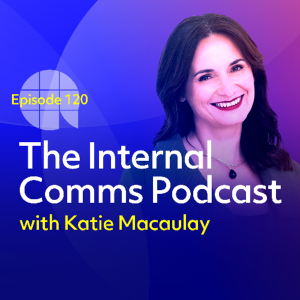
Episode 120 – Walk the line – how to stay in sync
June 11, 2025
In this episode of The Internal Comms Podcast, host Katie Macaulay sits down with alignment strategist and leadership coach Zora Artis to explore a crucial question: how can intern...
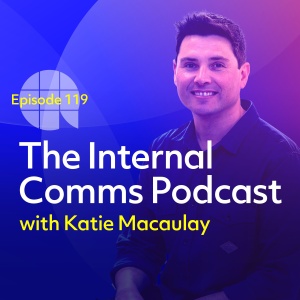
Episode 119 – The suite spot – Microsoft minus the mayhem
May 28, 2025
If the platforms you use at work were built by Microsoft, this episode is essential listening. Katie is joined by Alex Graves, Chief Visionary Officer at Silicon Reef — the peop...

Episode 118 – Satirising the spin – a bullsh*t investigation
May 14, 2025
If you have ever found yourself circling back, touching base, breaking down silos or leveraging strategic synergies — then these guests are speaking your language. Charles Firth...
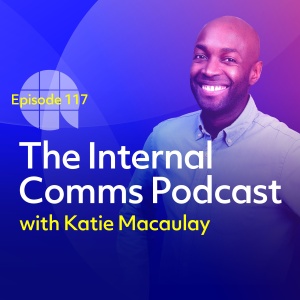
Episode 117 – From humanising a prime minister to empowering the quietest voices
May 12, 2025
What does it take to make one of the most scrutinised leaders in the world feel relatable? And how do we build internal comms that truly include everyone — especially the quieter...

Episode 116 – How to build a remarkable career without a plan
April 7, 2025
Fred Cook’s career proves success doesn’t require a straight line. Now Chairman Emeritus of global PR agency Golin, Fred has spent 35+ years advising world-famous brands – Am...

Episode 115 – Curiosity, creativity & the imposter myth
March 26, 2025
Inspiration is everywhere when you stay curious. That’s the thread running through this episode of The Internal Comms Podcast, where Katie Macaulay welcomes communication, creati...
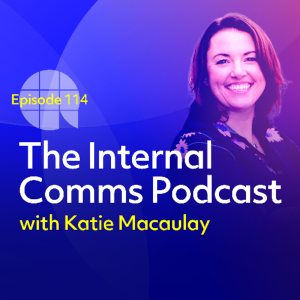
Episode 114 – The credibility code: Become the leader your team deserves
March 12, 2025
What does it mean to be a credible leader? And just how important is that credibility to your team? In this episode of The Internal Comms Podcast, host Katie Macaulay welcomes back...

Episode 113 – Soft skill? Think again: The hard truth about storytelling
February 26, 2025
In this episode of The Internal Comms Podcast, host Katie Macaulay welcomes Jeremy Connell-Waite, Global Communications Designer for IBM, an acclaimed speechwriter and storyteller,...

Episode 112 – From intent to impact: take charge of your career
February 20, 2025
We’re back for season 13 of The Internal Comms Podcast and to kick things off, host Katie Macaulay is joined by Eduvie Martin. Eduvie is Group Communications and Engagement Manag...
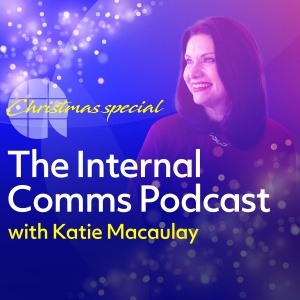
Season 12 – 2024 Christmas Special: nine gifts from the archive
December 18, 2024
In this episode, we mark a big milestone with a gift-wrapped edition of the Internal Comms Podcast. It’s six years since the show launched and, in this Christmas special, host K...
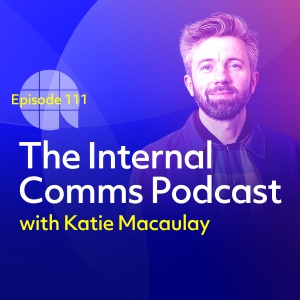
Episode 111 – A creative leader's blueprint for brilliance
December 4, 2024
This week on The Internal Comms Podcast, host Katie Macaulay is joined by a very special guest – AB's creative director, Joel O’Connor. Joel has been with AB for well over a de...
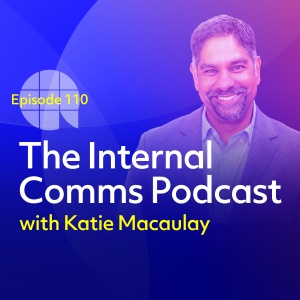
Episode 110 – Navigating the shifting digital landscape
November 20, 2024
This week on The Internal Comms Podcast, host Katie Macaulay is joined by co-founder of Local Wisdom, tech expert and comms leader Pinaki Kathiari. With his rare passion for both t...
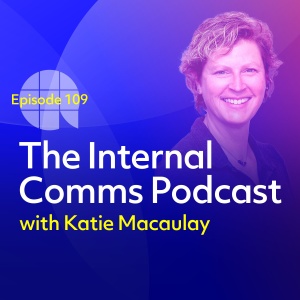
Episode 109 – The business of belonging: A new approach to DEI
November 6, 2024
We all deserve the opportunity to thrive at work. We deserve equal opportunity. We deserve to feel valued and included. That’s what diversity, equity and inclusion (DEI) is all a...
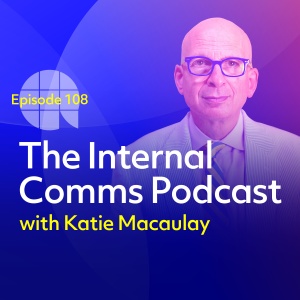
Episode 108 – Seth Godin rewrites the rules of internal communication
October 23, 2024
In this episode, Katie Macaulay is joined by author and influential blogger, Seth Godin. Seth was top of Katie’s guest wish list when The Internal Comms Podcast launched five ye...

Episode 107 – Beyond words: A blueprint for more impactful, immersive IC
October 9, 2024
In this episode of The Internal Comms Podcast, host Katie Macaulay welcomes international internal comms consultant and strategist Monique Zytnik to the hot seat. Monique is the au...

Episode 106 – School of thought: Inside Matt Tidwell’s comms curriculum
September 25, 2024
In this episode of The Internal Comms Podcast, host Katie Macaulay welcomes Matt Tidwell to the hot seat. Matt is a consultant, communicator and educator, and has led comms agencie...
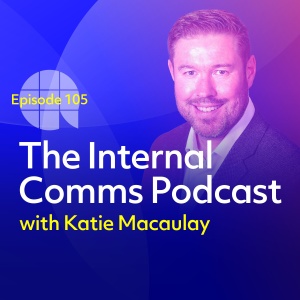
Episode 105 – Reaching the peak of success: IC at Iron Mountain
September 11, 2024
We’re back for Season 12 of The Internal Comms Podcast, and in this first episode, host Katie Macaulay is joined by Senior Director of Corporate Communication at Iron Mountain, N...
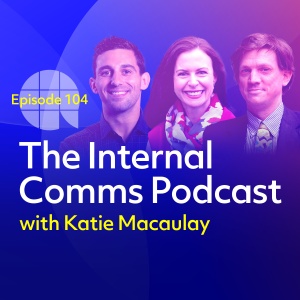
Episode 104 – Communications excellence in times of rapid change
July 31, 2024
McKinsey & Company is one of the world’s most renowned strategic management consultancies. With a mission of striving for “change that changes everything”, its global team of...
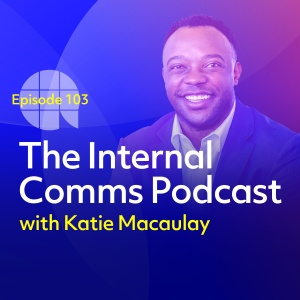
Episode 103 – Say the thing now: Candid conversations at Reddit
July 10, 2024
On a platform where the candid and the curious are king, how do you make sure what’s inside reflects what’s on the outside? Meet Sean Langston, Jr., Head of Internal Communicat...
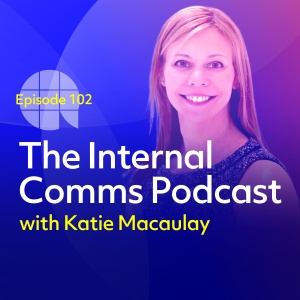
Episode 102 – The sound of success: IC at Spotify, Mastercard and beyond
June 26, 2024
Ever been curious about how some of the biggest brands in the world tackle their internal communication challenges? Well look (or listen) no further. Kerri Warner, this week’s gu...
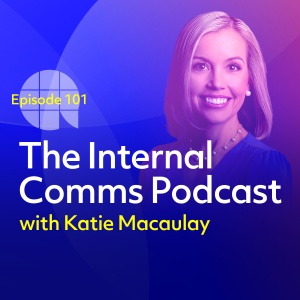
Episode 101 – From complex to clear: Elevate your presentations
June 12, 2024
As internal communicators, empowering leaders to clearly communicate business strategy, important updates and company values is a valued skill. How can we inspire colleagues and le...
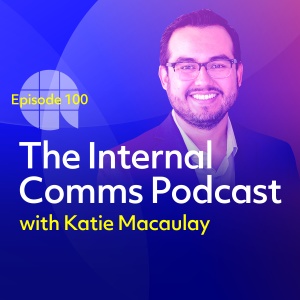
Episode 100 – Meet the super-connector behind #CommsJobs
May 29, 2024
After years running an internal communications team, Daniel Mendez emigrated from Chile to the U.S., where he faced a host of barriers to success. A language barrier. A small or no...

Episode 99 – The communicator’s communicator
May 15, 2024
In this episode of The Internal Comms Podcast, host Katie Macaulay is joined by Linda Zebian. The very first Director of Communications at PR management platform Muck Rack, Linda s...
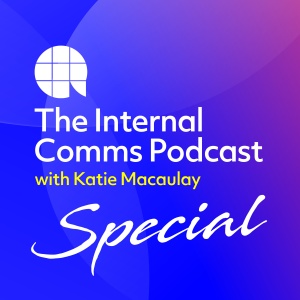
Exclusive reveal: Katie’s IC masterclass
May 1, 2024
Join us for a special episode of The Internal Comms Podcast as host Katie Macaulay announces the imminent launch of her unique on-demand masterclass. With more than three decades ...
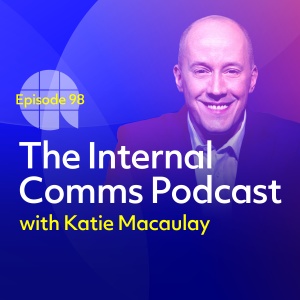
Episode 98 – How to build a powerful personal brand
April 17, 2024
This week on The Internal Comms Podcast, host Katie Macaulay is joined by serial entrepreneur, author, keynote speaker and business mentor Chris Ducker. Chris is a renowned expert ...

Episode 97 – Leaving the ladder down: helping IC pros step up
April 3, 2024
In this episode of The Internal Comms Podcast, host Katie Macaulay welcomes back the show’s first-ever guest, Rachel Miller. Rachel is an internationally recognised internal com...
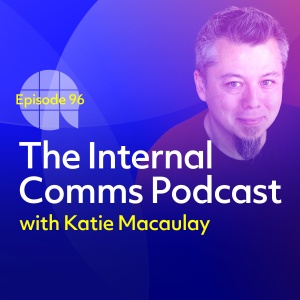
Episode 96 – Inclusion in action: Kindness is the keystone
March 20, 2024
This week on The Internal Comms Podcast, host Katie Macaulay is joined by Global Belonging, Equity and Impact Consultant, and self-styled ‘human-centric technologist’, Bob Wata...
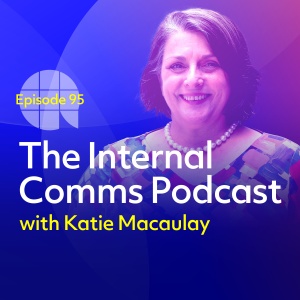
Episode 95 – Mastering your approach to strategic communication
March 6, 2024
This week on The Internal Comms Podcast, host Katie Macaulay is joined by award-winning marketing and communications expert Danielle Bond. Recently retired from corporate life, Da...
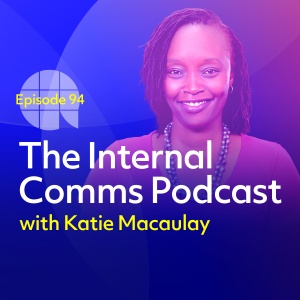
Episode 94 – The stories that shape us
February 21, 2024
In this episode of The Internal Comms Podcast, host Katie Macaulay is joined by leadership communications coach and co-founder of Engage Kenya, Agatha Juma. Agatha credits an emba...
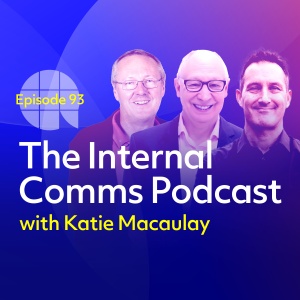
Episode 93 – The sound of success: Why it pays to listen to employees
February 7, 2024
We’re back for Season 11 of The Internal Comms Podcast! And kicking us off with a very special episode, this week host Katie Macaulay is joined by not one, not two, but three gue...
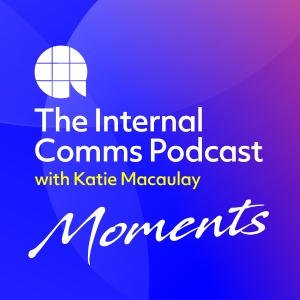
Moment 35 – The four Cs of content: How internal communicators can create comms that land
January 31, 2024
Looking for tips on creating internal communications that land – and stick? In this Moment from The Internal Comms Podcast, Steve Crescenzo shares a few things you absolutely mus...
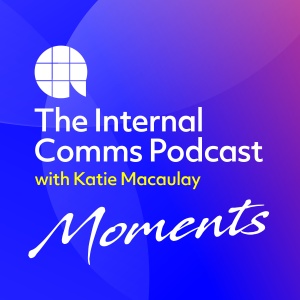
Moment 63 – Are you listening? The power of questions in leadership: Mike Roe
January 24, 2024
“I realised I was probably a pretty crap listener,” Mike Roe tells Katie Macaulay in this Moment from The Internal Comms Podcast. We often go to leaders and start by asking th...
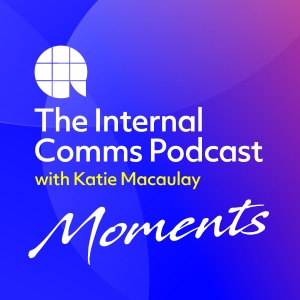
Moment 57 – Language matters: Building two-way engagement at IKEA
January 17, 2024
At IKEA, choosing the right words when communicating with the workforce is everything. Guy Britt, IKEA’s Global Head of Co-worker Comms, tells Katie Macaulay the use of ‘co-wo...

Episode 92 – Revolution coming: How AI is transforming internal comms
December 20, 2023
If you have ever attended one of Shel Holtz’s presentations, you will know that, more often than not, it’s standing room only. Shel has a remarkable ability to anticipate what'...
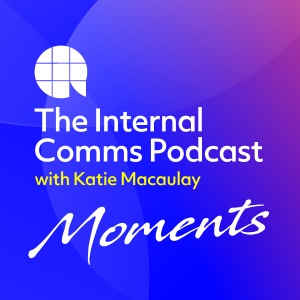
Moment 61 – Human-centric businesses do better: Victoria Dew
December 6, 2023
Does your approach to internal communication have the human touch? It’s essential to the humans you employ, says Victoria Dew, CEO of Dewpoint Communications and an internal com...
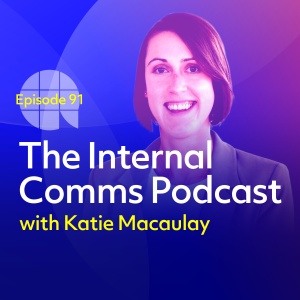
Episode 91 – How to build a one-person IC powerhouse
November 22, 2023
Ever feel like, as an internal communicator, you’re fighting an uphill battle all by yourself? This week’s guest on The Internal Comms Podcast has exactly what you need. Host ...
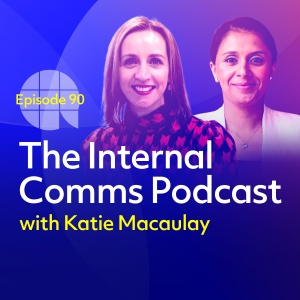
Episode 90 – A shared vision: ED&I and IC in action
November 8, 2023
This week on The Internal Comms Podcast, host Katie Macaulay is joined by Sim Sian, Head of Equality, Diversity and Inclusion at Mitie, and Yvonne O’Hara, formerly Mitie’s Grou...

Episode 89 – Netflix-style IC: Snackable, on-demand and authentic
October 25, 2023
In this episode of the Internal Comms Podcast, host Katie Macaulay is joined by Access Group’s Global Head of Communications and Engagement, Paul Downey. Paul caught Katie’s ...

Episode 88 – It’s fixable: How to tackle hard problems
October 11, 2023
In this episode of the Internal Comms Podcast, host Katie Macaulay is joined by Anne Morriss. Anne is an entrepreneur, author, public speaker, and the Executive Founder of the Lea...
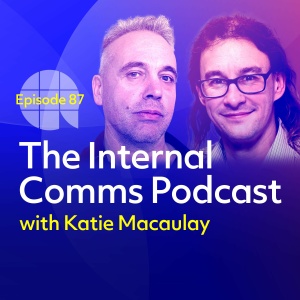
Episode 87 – Tracing the legacy of internal comms
September 27, 2023
It’s often said we must understand the past to build the future, and that sentiment sits at the very heart of this episode. This week on The Internal Comms Podcast we welcome pr...
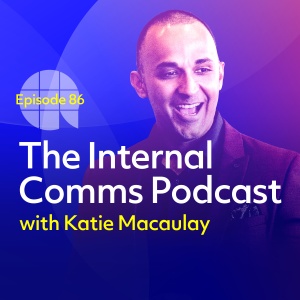
Episode 86 – How to crush your next public speaking gig
September 13, 2023
Season 10 of the Internal Comms Podcast kicks off with one of Katie’s most compelling conversations yet. Shil Shanghavi is a public speaking specialist, storyteller and head of...

Coming soon: Season 10 of The Internal Comms Podcast
September 6, 2023
Our summer break is drawing to a close, Katie has dusted off her mic and we’re ready to launch Season 10 of The Internal Comms Podcast! This season, we’ll be welcoming more o...

Moment 18 – 3% of employees are driving 90% of conversations: Mike Klein
August 30, 2023
In this moment, we catch up with Mike Klein, former political consultant, modern-day communications stalwart, and two-time guest on the Internal Comms Podcast. Mike breaks down h...
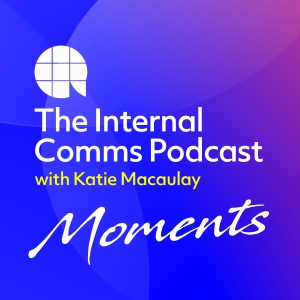
Moment 17 – How we create meaning: Sue Dewhurst & Liam FitzPatrick
August 23, 2023
What’s our one true purpose as internal communicators? It’s the question we’re all seeking the answer to. This moment takes us back to when Katie first welcomed Sue Dewhurs...

Moment 13 – The message must change at each leadership level: Dr Kevin Ruck
August 16, 2023
If there’s one thing we’re clear about at AB, it’s that communication should not be a one-way street. And that’s what this moment is about. We head back to Episode 13, w...

Moment 06 – On tolerance, kindness and being enough: Henry Normal
August 9, 2023
As communicators, we could often do with slowing things down a little. In this moment, Henry Normal – author and co-founder of production company Baby Cow, which he founded with ...
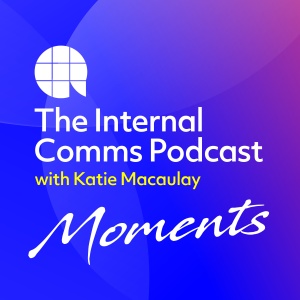
Moment 01 – What happens inside is reflected outside: Rachel Miller
August 2, 2023
Have you heard of an inside-out approach to communication? It’s no secret that today’s internal comms messages seep into the world outside the office walls. After all, anythi...
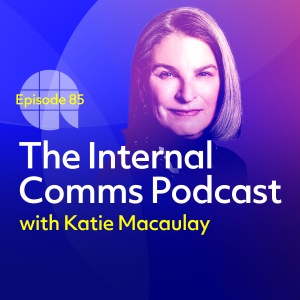
Episode 85 – Lessons from a trailblazer
July 26, 2023
We’re ending Season 9 of the Internal Comms Podcast with a bang this week, as Sally Susman takes to the hot seat for her second appearance. Sally is Executive Vice President an...
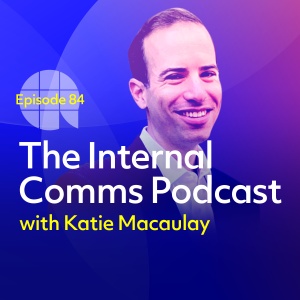
Episode 84 – Ethics in action: Insights from a global compliance leader
July 12, 2023
In modern business, integrity is non-negotiable. As legislation ramps up in lockstep with colleague and customer demands, operating an ethical business in line with global regula...

Episode 83 – ESG: How IC can drive the agenda
June 28, 2023
Define ESG… Well, it stands for environment, social and governance. But can you really define what ESG actually is? Put very simply, ESG is a set of criteria used to evaluate a ...
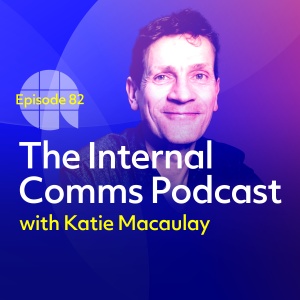
Episode 82 – The truth about resilience
May 31, 2023
It seems everyone’s talking about resilience, the ability to bounce back from misfortune or adversity. But as Bruce Daisley explains to host Katie Macaulay, there’s something w...
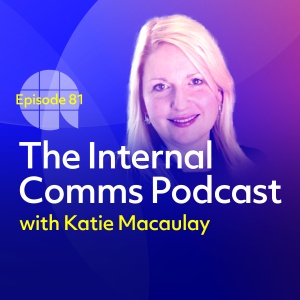
Episode 81 – Unilever: Inside a global success story
May 17, 2023
With over 130,000 colleagues, and a 100-year history, Unilever is one of the world’s largest consumer goods companies. And this week on the Internal Comms Podcast, we get a peek ...
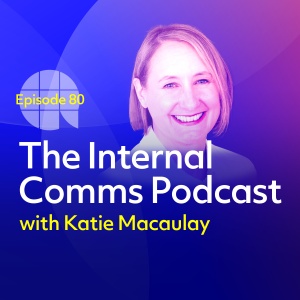
Episode 80 – The inside track on comms at Mercedes F1
May 3, 2023
“The days we fail are the days our competitors live to regret,” said the late, great Niki Lauda. And that’s what this episode of the Internal Comms Podcast is all about. Thi...

Episode 79 – Lifting the lid on comms consultancy
April 19, 2023
Ever considered what it takes to become an effective communications consultant? Then this week’s episode of The Internal Comms Podcast is for you. Host Katie Macaulay welcomes Si...

Episode 78 – Comms with courage
April 5, 2023
This week on The Internal Comms Podcast, host Katie Macaulay welcomes Audacity’s Jason Anthoine. Jason has spent three decades working in internal communication, employee experie...
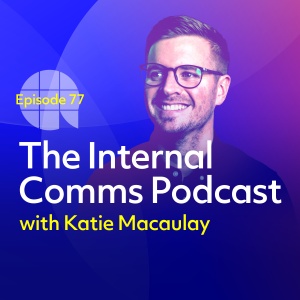
Episode 77 – Here for the culture
March 22, 2023
This week on The Internal Comms Podcast, host Katie Macaulay welcomes culture-chameleon Shane Hatton. Shane is many things – author, international speaker, trainer, leadership co...

Episode 76 – Employee experience: For the people by the people
March 8, 2023
This week on The Internal Comms Podcast, host Katie Macaulay welcomes Nicholas Wardle. Nicholas is Head of Employee Experience at Brand Experiences, and co-author of ‘Monetising ...

Episode 75 – Inside the world’s most famous corner shop
February 22, 2023
This week on The Internal Comms Podcast, host Katie Macaulay welcomes Sam Bleazard. Sam’s role as Employer Brand Content Producer takes him behind the scenes of ‘the world’s ...

Episode 74 – Culture with sticking power
February 8, 2023
The Internal Comms Podcast is back for Season 9! To kick off this season, we welcomed BizJuicer’s Andy Goram to the hot seat. Andy’s passion for building businesses ‘from t...

Season 8: In the rear view mirror
February 1, 2023
With Season 9 of The Internal Comms Podcast right around the corner, host Katie Macaulay has taken the opportunity to reflect on the wisdom and insight shared over our latest seaso...
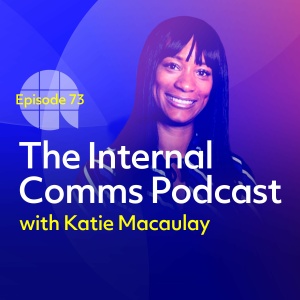
Episode 73 – Forging your own path
December 21, 2022
The season 8 finale features Jennifer Thomas, Head of Communications for the Data & Analytics branch of the London Stock Exchange Group. Born in London to Guyanese parents, Jennif...
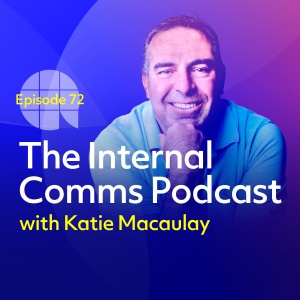
Episode 72 – Making your way to the top
December 7, 2022
Episode 72 of The Internal Comms Podcast sees host Katie Macaulay joined by Adrian Cropley, CEO and founder of Cropley Communication and the Centre for Strategic Communication Exce...

Episode 71 – Effective comms starts with knowing yourself
November 23, 2022
This week’s guest on The Internal Comms Podcast is Joanna Parsons, Head of Internal Communications & Culture at Teamwork. Joanna made Irish history as the first ever Head of Inte...
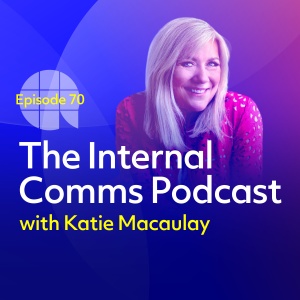
Episode 70 – Reaching across the aisle
November 9, 2022
Shelby Scarbrough, author of 'Civility Rules! Creating a Purposeful Practice of Civility', shares her deep insight and experience ‘reaching across the aisle’ on episode 70 of T...

Episode 69 – Measuring what matters – actions not feelings
October 26, 2022
Episode 69 of The Internal Comms Podcast sees IC heavyweight Mike Klein return to the hot seat. An internal and social communication consultant based out of Reykjavik, Mike is help...

Episode 68 – Host in the hot seat: Reflections on 250,000 plays
October 12, 2022
In this very special episode of The Internal Comms Podcast, the tables have turned. Katie Macaulay is in the hot seat, and AB’s Senior Content Editor Freddie Reynolds takes over ...
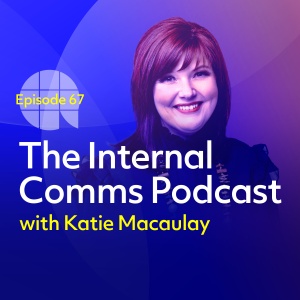
Episode 67 – The ABC of research: Ask, believe, change
September 28, 2022
In this episode of The Internal Comms Podcast, host Katie Macaulay invites qualitative research expert Mari Lee to sit in the hot seat. Mari’s specialism is in ‘development com...
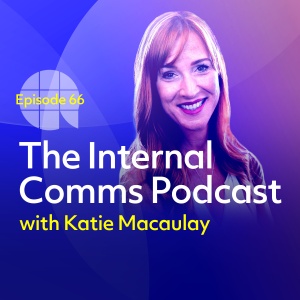
Episode 66 – Combatting IC isolation
September 14, 2022
The Internal Comms Podcast is back for what promises to be an incredible Season 8! In this kick-off episode, host Katie Macaulay welcomes ICology’s Vice President of Community an...

Season 7: The rewind episode
September 7, 2022
The countdown is on, and The Internal Comms Podcast will be returning from its summer break with Season 8 imminently. And while its eighth instalment promises wisdom unbound from a...

Episode 65 – Remote but not unreachable
June 22, 2022
In the final episode of season 7 of The Internal Comms Podcast, host Katie Macaulay speaks with Lily Goodman D’Amato, Delivery Trainer at US-based digital pharmacy Medly. Lily b...

Episode 64 – Releasing your inner sceptic
June 8, 2022
In the latest episode of The Internal Comms Podcast, host Katie Macaulay speaks with Martin Flegg, founder and co-owner of The IC Citizen internal communications consultancy. With...
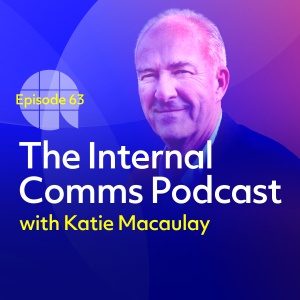
Episode 63 – Lessons in leadership
May 25, 2022
In episode 63 of The Internal Comms Podcast, host Katie Macaulay meets Mike Roe, who had a 28-year career in the police force and is now CEO of Tensense, a data insights company. ...
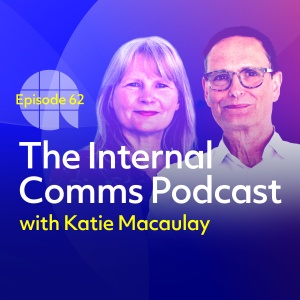
Episode 62 – Textbook IC: rewriting comms for a new era
May 11, 2022
In the latest episode of The Internal Comms Podcast, host Katie Macaulay speaks with the duo who wrote the book on internal communications – literally. Sue Dewhurst has worked i...

Episode 61 – Embracing the messiness of being human
April 27, 2022
In this week’s episode of The Internal Comms Podcast, host Katie Macaulay sits down with Victoria Dew, founder and CEO of Dewpoint Communications. Her firm is focused on helping ...
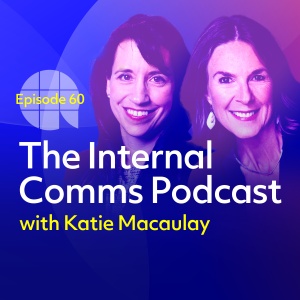
Episode 60 – How to have better conversations
April 13, 2022
In this week’s episode of The Internal Comms Podcast, host Katie Macaulay sits down with Jackie Stavros and Cheri Torres, co-authors of Conversations Worth Having, Using Apprecia...

Episode 59 – Strategy & IC: A masterclass in collaboration
March 30, 2022
In this episode of The Internal Comms Podcast, host Katie Macaluay looks into the dynamic between internal comms and strategy – at its best a symbiotic relationship that drives t...
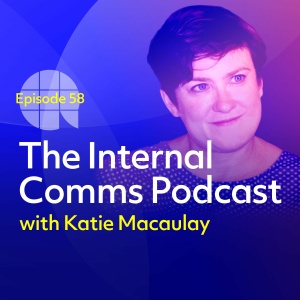
Episode 58 – The state of IC: what’s behind the numbers?
March 16, 2022
In episode 58 of The Internal Comms Podcast, we dissect the results of the latest State of the Sector report, the definitive global survey of the internal communication landscape, ...
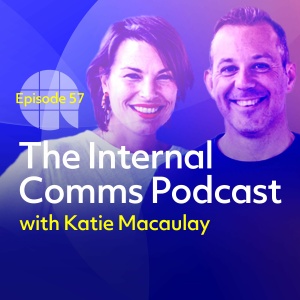
Episode 57 – Unboxing internal comms at IKEA
March 2, 2022
In episode 57 of The Internal Comms Podcast, listeners can take a peek inside the world of IC at IKEA, as host Katie Macaulay chats with a dynamic duo from the multinational furnit...
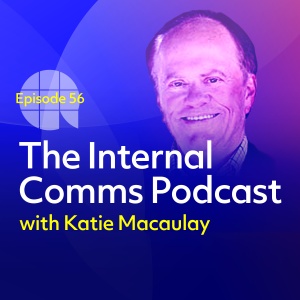
Episode 56 – IC at the sharp end
February 16, 2022
In this first episode of season 7 of The Internal Comms Podcast, host Katie Macaulay talks to Jim Shaffer, an internationally recognised business adviser, leadership coach, author ...
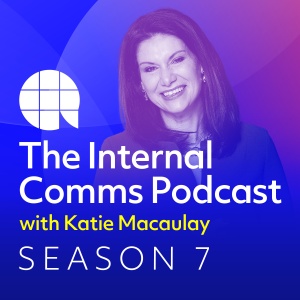
Leading Lights – Highlights From Season 6
February 9, 2022
Get ready to tune in to our next season of The Internal Comms Podcast. While Season 7 promises an amazing array of guests, this special episode highlights some of the best moments ...
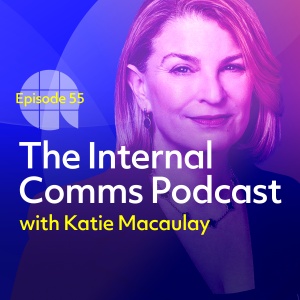
Episode 55 – Mission Possible
December 1, 2021
In the final episode of season 6 of The Internal Comms Podcast, host Katie Macaulay speaks to Sally Susman, Executive Vice President and Chief Corporate Affairs Officer at Pfizer. ...
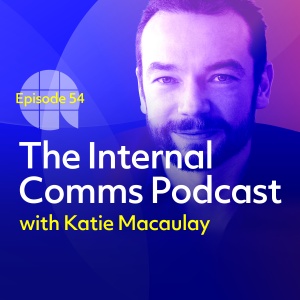
Episode 54 – Brain care: Mastering your mind
November 17, 2021
In the sixth episode of season 6 of The Internal Comms Podcast, host Katie Macaulay talks to Phil Dobson, founder of BrainWorkshops and author of The Brain Book: How to Think and W...

Episode 53 – Suicide Prevention: Reflecting on an award-winning campaign
November 3, 2021
***The content in this episode of The Internal Comms Podcast may be triggering for those who have experience of suicide.*** In the fourth episode of season 6 of The Internal Comms...

Episode 52 – How do you create comms with purpose?
October 20, 2021
In the fourth episode of season 6 of The Internal Comms Podcast, host Katie Macaulay catches up with Maliha Aqeel, Director of Global Communications and Digital Channels at Fix Net...
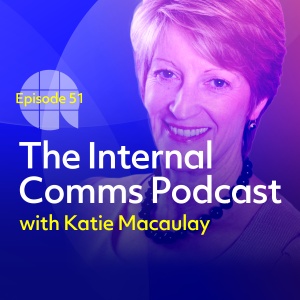
Episode 51 – Why are we here? How purpose and values drive healthy cultures
October 6, 2021
In the third episode of season 6 of The Internal Comms Podcast, host Katie Macaulay catches up with communications expert and IABC Fellow Jane Mitchell. Jane began her career with...

Episode 50 – A guru’s guide to internal podcasts
September 22, 2021
In the second episode of season 6 of The Internal Comms Podcast, host Katie Macaulay talks to Brian Landau, an authority in podcasting and expert on all things audio content creati...
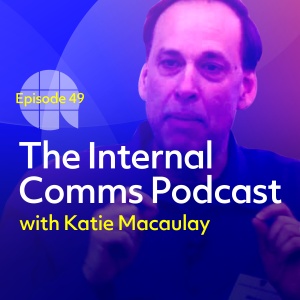
Episode 49 – Engagement: how it started, how it's going
September 8, 2021
In this first episode of season 6 of The Internal Comms Podcast, host Katie Macaulay talks to the father of employee engagement, organisational psychologist Professor William Kahn....
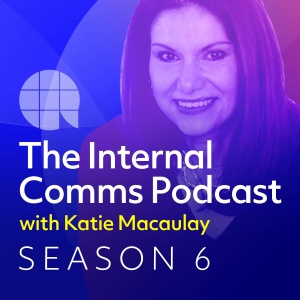
Industry experts – highlights from Season 5
September 1, 2021
The curtain is about to go up on the new season of The Internal Comms Podcast, with some fantastic guests joining host Katie Macaulay to talk about all things communication. For t...
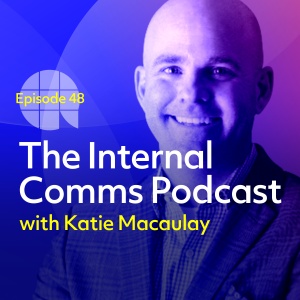
Episode 48 – Changing minds: using behavioural science in IC
May 12, 2021
It has always been Katie Macaulay’s goal for The Internal Comms Podcast to help improve the way organisations communicate with their people, and this week she does so by explorin...
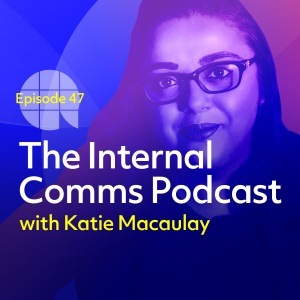
Episode 47 – Conversation with a comms rebel
April 28, 2021
Katie Macaulay’s guest this week is a leading light in efforts to advance the careers of under-represented groups in IC. Advita Patel is a qualified coach, mentor, public speake...
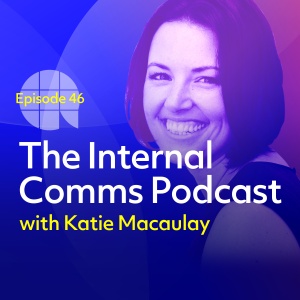
Episode 46 – Influential Internal Communication
April 14, 2021
This episode sees the return of the brilliant business communications strategist, international public speaker and podcast host Jenni Field. The immediate past chair of the Charte...
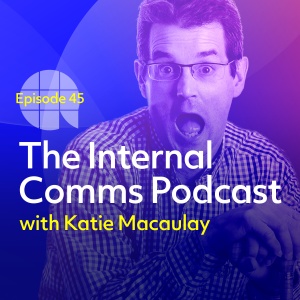
Episode 45 – Sharing the magic
March 31, 2021
The life and career of this week’s guest has been a literal roller coaster. Mark Webb fell into PR and media relations by chance, after spotting a job ad for the new Eurodisney ...

Episode 44 – How to prove your presence
March 17, 2021
Katie Macaulay’s guest for episode 44 of The IC Podcast is Canadian comms expert Prarthna Thakore. After beginning her career in Calgary and then moving to London, Prarthna has ...
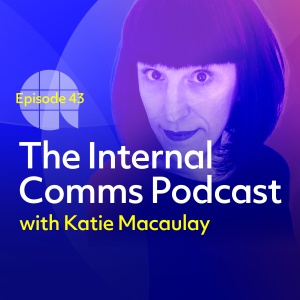
Episode 43 – Kate Jones on the state of our sector
March 3, 2021
Every year since 2008, internal comms pros have responded to the Gallagher State of the Sector report. Because it’s been running for 13 years, and because similar questions are a...

Episode 42 – Once Upon A Time In IC
February 17, 2021
Katie Macaulay kicks off Season 5 of The IC Podcast with a riveting conversation with business storytelling specialist Gabrielle Dolan. Gabrielle is a highly sought-after internat...

Looking back, looking forward: highlights from Season 4
February 10, 2021
With the new season of The Internal Comms Podcast just around the corner, we wanted to whet your appetite with a selection of the best bits from Season 4. For this special best-of...
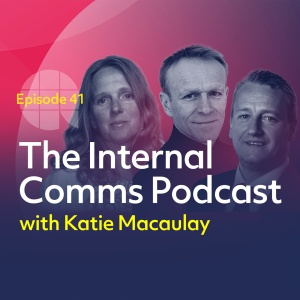
Episode 41 – At the heart of the crisis: NHS comms during Covid-19
December 23, 2020
The NHS has never been far from our hearts and minds over the last few months. As the national jewel in the UK’s crown, the National Health Service has battled many difficulties ...

Episode 40 – Founding fathers – building the first IC agency
December 17, 2020
What prompted the creation of the first IC agency back in 1964 and what convinced those first chief executives that they needed external help communicating with their employees? W...
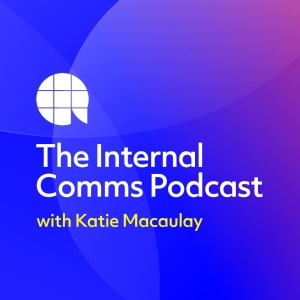
Coming soon in season 4
December 9, 2020
Coming soon in season 4 of The Internal Comms Podcast
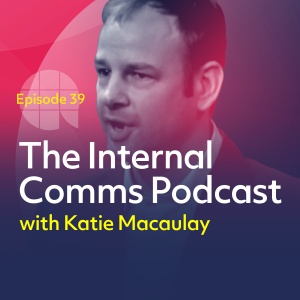
Episode 39 – Evidence-based IC
November 25, 2020
Recent research shows measurement is particularly challenging for many internal comms professionals. Katie’s guest on this episode of The Internal Comms Podcast is Benjamin Ellis...

Episode 38 – The secret thoughts of successful people
November 11, 2020
Amid the turmoil of 2020, with IC pros thrown into the spotlight as we strive to keep colleagues informed and connected, it’s not surprising that many of us are feeling a degree ...
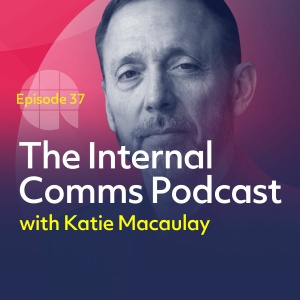
Episode 37 – The art of negotiation
October 28, 2020
If you want to take your communication skills to the next level, then this episode of The Internal Comms Podcast is for you. Katie’s guest is a formidable negotiator and expert ...

Episode 36 – Navigating the digital landscape
October 14, 2020
In this episode of The Internal Comms Podcast we meet digital expert Frank Wolf. Frank spent seven years as a business consultant at Accenture. Then at T Mobile, he was responsible...

Episode 35 – How to do less, but do it better
September 30, 2020
In this episode of The Internal Comms Podcast we meet Steve Crescenzo, a witty, straight-talking and charismatic speaker, workshop leader and coach from Chicago, USA, who has spent...

Episode 34 – Cross-cultural comms
September 16, 2020
The Internal Comms Podcast is now in its fourth season – and to kick it off Katie sat down with Tasneem Chopra for some honest and open conversation. The self-styled “professi...
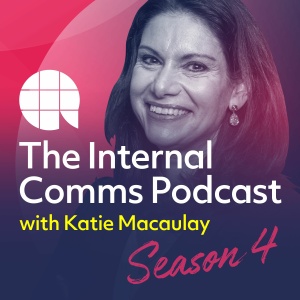
Choice cuts: highlights from Season 3 of The IC Podcast
September 2, 2020
Before the curtain lifts on Season 4 of The IC Podcast, we wanted to leave you with some food for thought from Season 3. And what a season it was; we had a whole host of remarkabl...
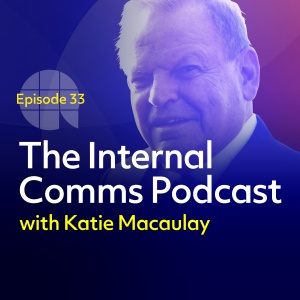
Episode 33 – IC’s founding father
July 8, 2020
The goal of this podcast is to bring you meaningful, in-depth conversations with people who are helping to shape the world of internal communication: practitioners, leaders, author...
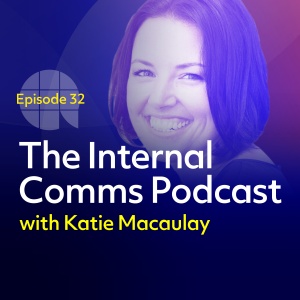
Episode 32 – Leadership in unprecedented times
June 24, 2020
President of the Chartered Institute of Public Relations (CIPR), Jenni Field has more than 16 years’ experience in communications. She is the founder and director of Redefining C...
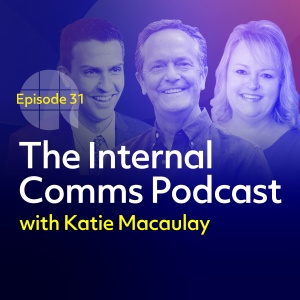
Episode 31 – What's next? IABC roundtable on the impact of Coronavirus
June 10, 2020
The Internal Comms Podcast has gone truly global with our latest episode featuring three speakers from three countries. In episode 31 Katie tables a roundtable discussion with Jen...

Episode 30 – Your biggest, best, boldest self
May 27, 2020
Chief Executive of the Office for Nuclear Regulation (ONR), Adriènne Kelbie has an exceptional understanding of the true power of communication and engagement. The first woman to ...

Episode 29 – Crisis communication at the coalface
May 13, 2020
Katie’s guest this week is someone who is no stranger to crisis communication. Amanda Coleman was the Director of Corporate Communication at Greater Manchester Police when, on M...
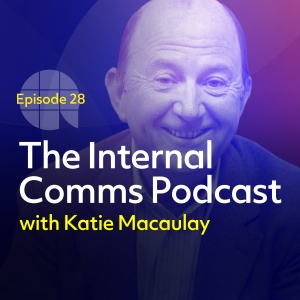
Episode 28 – The Godfather of IC
April 29, 2020
Katie’s guest this week is one of the world’s leading authorities on internal comms and the management of change: Bill Quirke. As managing director of IC consultancy Synopsis,...
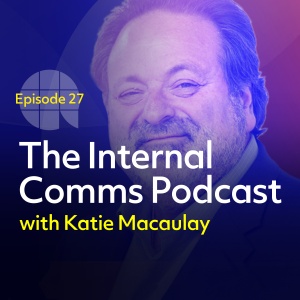
Episode 27 – Stepping up in a Crisis
April 14, 2020
This week Katie speaks to renowned communicator Shel Holtz. As listeners continue to grapple with keeping workforces informed, galvanised and feeling connected during the corona cr...
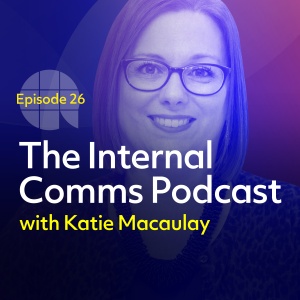
Episode 26 – How to thrive in IC (Part II)
April 1, 2020
This episode is recorded as the majority of the UK is in lockdown while the country attempts to flatten the curve of the COVID-19 pandemic. Katie Macaulay’s guest, Rachel Miller...
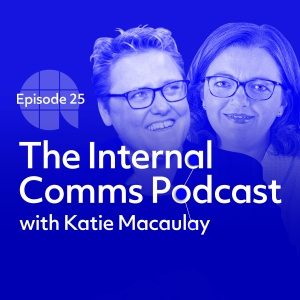
Episode 25 – Crisis Communications: Covid-19 Special
March 25, 2020
Katie Macaulay recorded this special episode on Friday 20 March 2020 in response to the rapidly developing situation surrounding the Covid-19 pandemic. Her guests to talk all thin...
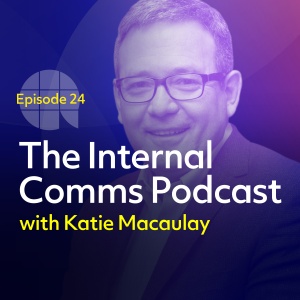
Episode 24 – A view from the top
March 18, 2020
In this episode of The Internal Comms Podcast, Katie puts her first CEO in the hotseat: Marc Barone. Marc is chief executive for continental Europe at AECOM. This Fortune 500 comp...

Episode 23 – Courage, confidence and communication
March 4, 2020
In this episode of The Internal Comms Podcast Katie talks to one of world’s most qualified communicators, Priya Bates, from Canada. Priya has an Accredited Business Communicator...
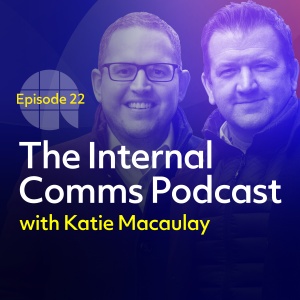
Episode 22 – State of the Sector
February 19, 2020
State of the Sector is the longest-established and most in-depth survey of the internal communication profession, based on responses from more than 1,000 professionals around the w...
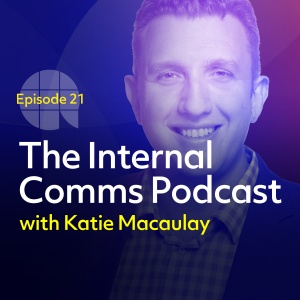
Episode 21 – The cheerleader for IC
February 5, 2020
During Seasons One and Two we covered a lot of ground in IC and beyond. As we begin Season Three, brace yourself for more fascinating insights as we delve into the very heart of co...
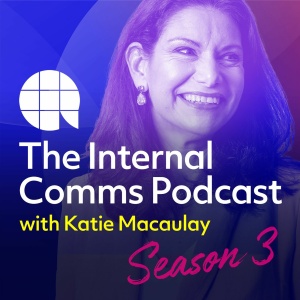
The highlight reel – nuggets of wisdom from Season 1 and 2 of The IC Podcast
January 29, 2020
Since the launch of The Internal Comms Podcast, host Katie Macaulay has interviewed more than 20 fascinating guests from the world of IC and beyond. Now, as we gear up for Season ...
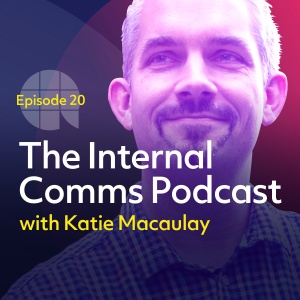
Episode 20 – Advocacy in action
December 18, 2019
Katie’s guest this week is Keith Lewis, UK Social Media and Social Business Manager for Zurich Insurance – one of the world’s largest insurance groups with 55,000 employees i...

Episode 19 – The appliance of neuroscience
December 4, 2019
Katie Macaulay’s guest this week is a neuroscientist with extensive experience in the field of organisational change. Hilary Scarlett began studying the brain in 2009 after read...
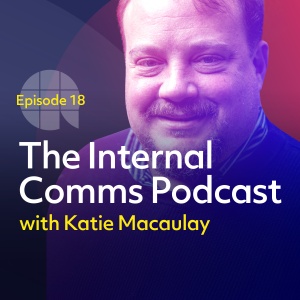
Episode 18 – Editing organisations
November 20, 2019
In this episode we get up close and personal with someone who helps improve the way we communicate at work. Mike Klein worked as a political consultant in the US, but for the past...

Episode 17 – Black Belt Thinking
November 6, 2019
As individuals, this week’s guests have impressive CVs. Sue Dewhurst is an experienced internal communicator who, for many years, has been training and coaching thousands of lea...
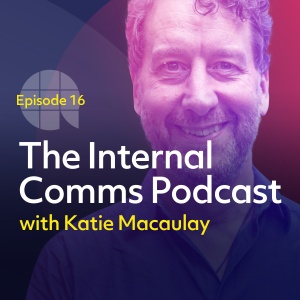
Episode 16 – A Passage to India
October 23, 2019
With this podcast now reaching listeners in 50 countries worldwide, host Katie Macaulay has chosen to go international for this episode. Her guest is creative services entrepreneu...
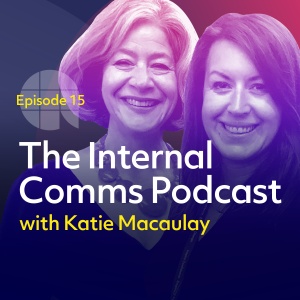
Episode 15 – The Power of Two
October 8, 2019
This week, Katie meets Claire Hyde and Louise Wadman, joint heads of IC at KPMG UK. Possibly the most senior IC job share in the country, Claire and Louise have more than 45 years...

Episode 14 – How to start a movement
September 24, 2019
Katie’s guest this episode is Nita Clarke – whose services to employee engagement have earned her an OBE from the Queen. Nita has a long and fascinating career. She co-authore...

Episode 13 – A check-up with the IC doctor
September 11, 2019
The Internal Comms Podcast is back with a new series of fortnightly conversations with leading lights from the world of internal communications, engagement and leadership. AB Mana...
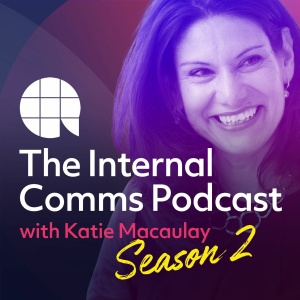
Season 02 Trailer
September 6, 2019
Season two of The Internal Comms Podcast is almost here!
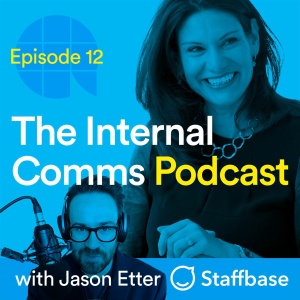
Episode 12 – Listen and learn: insights from 30 years in IC
July 24, 2019
In this extra special bonus episode of The Internal Comms Podcast, the tables are turned on Katie as she takes the spotlight as an interviewee. Posing the searching questions is J...

Episode 11 – Putting the soul back into Patisserie Valerie
June 25, 2019
For this special bonus episode of The IC Podcast, Katie interviewed Paolo Peretti, Managing Retail Director of Patisserie Valerie, in front of a live audience at AB Thinks Live, ou...
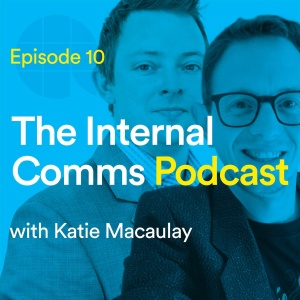
Episode 10 – Internal comms at the sharp end - recorded at IoIC live
May 21, 2019
For the final episode of season one, Katie Macaulay travels to Bath for IoIC Live and interviews two of the conference’s speakers, Martin Fitzpatrick and Matt Batten. Both Marti...

Episode 09 – How to win colleagues and influence people
May 7, 2019
Social influencer marketing is a new and rapidly growing means of getting your message out to your audience. It’s changed the face of advertising and has everyone from up-to-the-...

Episode 08 – The Joy of Work
April 23, 2019
Katie’s guest this week is an extremely versatile communicator. In his day job as European Vice President of Twitter, Bruce Daisley has overseen the development of one of the wor...
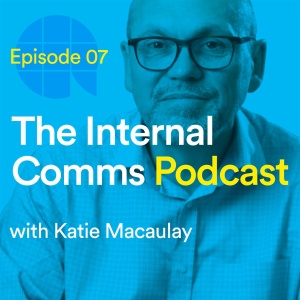
Episode 07 – What social purpose (really) means
April 9, 2019
Running the UK’s largest retail and financial services network with more branches than all of the UK’s banks and building societies put together, the Post Office is at the hear...

Episode 06 – The craft of communication
March 27, 2019
In episode six, Katie travels beyond the boundaries of internal comms to find out how to write more engagingly, tell better stories and use humour to deliver your message. And who ...
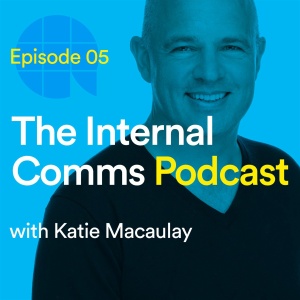
Episode 05 – Learning comms lessons from PR
March 13, 2019
In episode five, Katie aims to find out what internal communications can learn from external communications. So she sits down with ‘mister public relations’, Stephen Waddington...
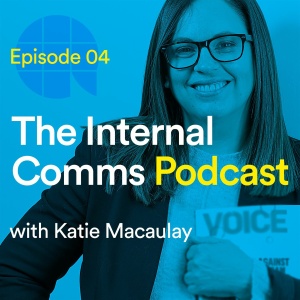
Episode 04 – What it means to be the voice of IC
February 27, 2019
The Institute of Internal Communication (IoIC) is the voice of the IC profession – dedicated to strengthening confidence, credibility and community. And on 12 March, the IoIC cel...
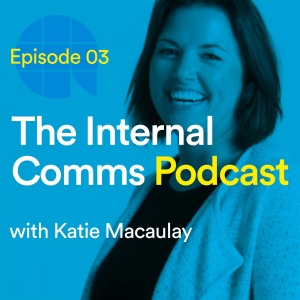
Episode 03 – What the State of the Sector report means for IC
February 13, 2019
Episode three lands as Gatehouse’s latest State of the Sector report is published. Katie invites Jenni Field, a tireless, high-profile personality of the IC landscape, to discus...
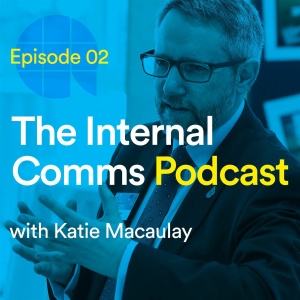
Episode 02 – What it takes to be an IC leader
January 30, 2019
Even if you’re only vaguely familiar with internal communications, Katie’s guest in episode two will no doubt be a name you recognise. In a career spanning 30 years, Russell G...

Episode 01 – How to thrive in IC
January 16, 2019
In the first episode of The Internal Comms Podcast, Katie meets Rachel Miller – a prolific blogger, educator, keynote speaker and one of the most respected voices in internal com...
